
python-aiplatform
A Python SDK for Vertex AI, a fully managed, end-to-end platform for data science and machine learning.
Stars: 792
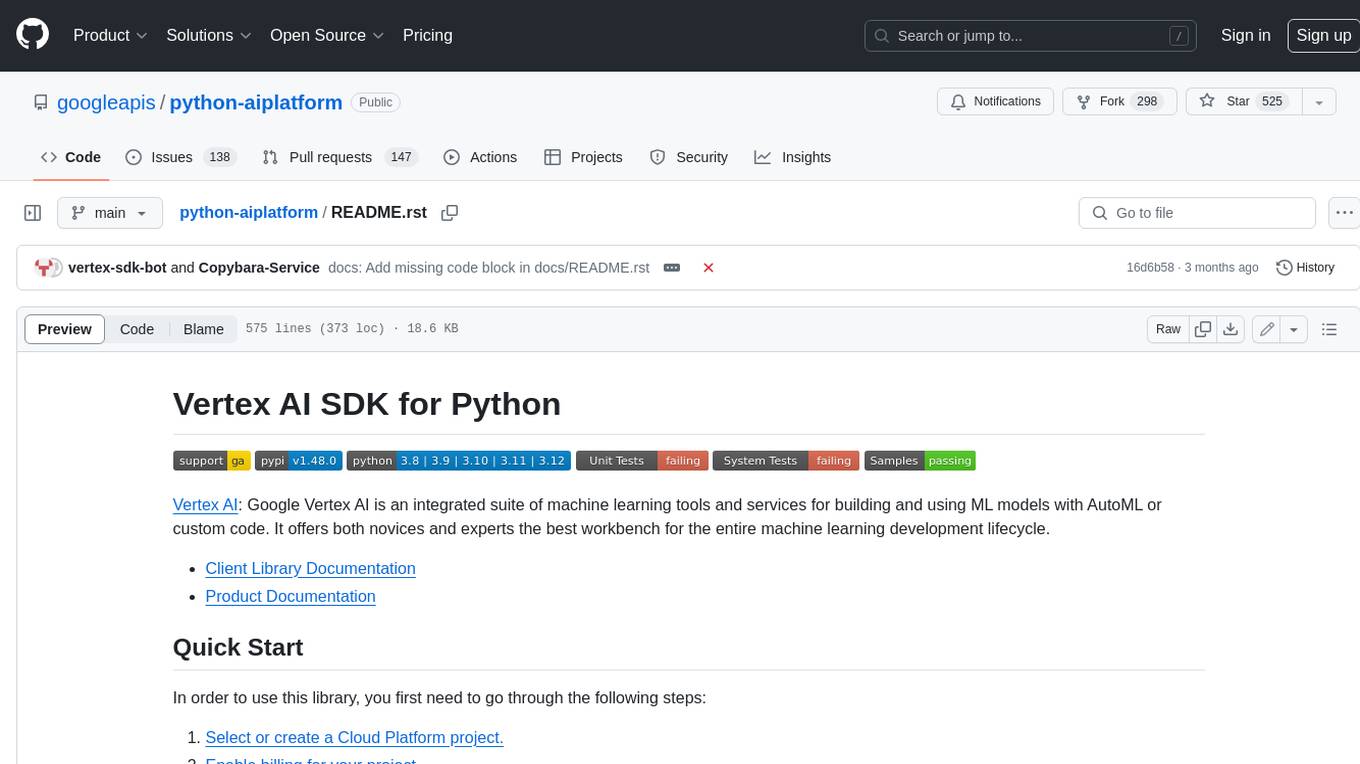
The Vertex AI SDK for Python is a library that provides a convenient way to use the Vertex AI API. It offers a high-level interface for creating and managing Vertex AI resources, such as datasets, models, and endpoints. The SDK also provides support for training and deploying custom models, as well as using AutoML models. With the Vertex AI SDK for Python, you can quickly and easily build and deploy machine learning models on Vertex AI.
README:
|GA| |pypi| |versions| |unit-tests| |system-tests| |sample-tests|
Vertex AI_: Google Vertex AI is an integrated suite of machine learning tools and services for building and using ML models with AutoML or custom code. It offers both novices and experts the best workbench for the entire machine learning development lifecycle.
-
Client Library Documentation_ -
Product Documentation_
.. |GA| image:: https://img.shields.io/badge/support-ga-gold.svg :target: https://github.com/googleapis/google-cloud-python/blob/main/README.rst#general-availability .. |pypi| image:: https://img.shields.io/pypi/v/google-cloud-aiplatform.svg :target: https://pypi.org/project/google-cloud-aiplatform/ .. |versions| image:: https://img.shields.io/pypi/pyversions/google-cloud-aiplatform.svg :target: https://pypi.org/project/google-cloud-aiplatform/ .. |unit-tests| image:: https://storage.googleapis.com/cloud-devrel-public/python-aiplatform/badges/sdk-unit-tests.svg :target: https://storage.googleapis.com/cloud-devrel-public/python-aiplatform/badges/sdk-unit-tests.html .. |system-tests| image:: https://storage.googleapis.com/cloud-devrel-public/python-aiplatform/badges/sdk-system-tests.svg :target: https://storage.googleapis.com/cloud-devrel-public/python-aiplatform/badges/sdk-system-tests.html .. |sample-tests| image:: https://storage.googleapis.com/cloud-devrel-public/python-aiplatform/badges/sdk-sample-tests.svg :target: https://storage.googleapis.com/cloud-devrel-public/python-aiplatform/badges/sdk-sample-tests.html .. _Vertex AI: https://cloud.google.com/vertex-ai/docs .. _Client Library Documentation: https://cloud.google.com/python/docs/reference/aiplatform/latest .. _Product Documentation: https://cloud.google.com/vertex-ai/docs
Generative AI in the Vertex AI SDK
To use Gen AI features from the Vertex AI SDK, you can instantiate a Gen AI client with the following:
.. code-block:: Python
import vertexai
from vertexai import types
# Instantiate GenAI client from Vertex SDK
# Replace with your project ID and location
client = vertexai.Client(project='my-project', location='us-central1')
See the examples below for guidance on how to use specific features supported by the Gen AI SDK client.
Gen AI Evaluation
^^^^^^^^^^^^^^^^^
To run evaluation, first generate model responses from a set of prompts.
.. code-block:: Python
import pandas as pd
prompts_df = pd.DataFrame({
"prompt": [
"What is the capital of France?",
"Write a haiku about a cat.",
"Write a Python function to calculate the factorial of a number.",
"Translate 'How are you?' to French.",
],
"reference": [
"Paris",
"Sunbeam on the floor,\nA furry puddle sleeping,\nTwitching tail tells tales.",
"def factorial(n):\n if n < 0:\n return 'Factorial does not exist for negative numbers'\n elif n == 0:\n return 1\n else:\n fact = 1\n i = 1\n while i <= n:\n fact *= i\n i += 1\n return fact",
"Comment ça va ?",
]
})
inference_results = client.evals.run_inference(
model="gemini-2.5-flash-preview-05-20",
src=prompts_df
)
Then run evaluation by providing the inference results and specifying the metric types.
.. code-block:: Python
eval_result = client.evals.evaluate(
dataset=inference_results,
metrics=[
types.Metric(name='exact_match'),
types.Metric(name='rouge_l_sum'),
types.RubricMetric.TEXT_QUALITY,
]
)
Prompt optimization
^^^^^^^^^^^^^^^^^^^
To do a zero-shot prompt optimization, use the `optimize_prompt`
method.
.. code-block:: Python
prompt = "Generate system instructions for a question-answering assistant"
response = client.prompt_optimizer.optimize_prompt(prompt=prompt)
print(response.suggested_prompt)
To call the data-driven prompt optimization, call the `optimize` method.
In this case however, we need to provide `vapo_config`. This config needs to
have either service account or project **number** and the config path.
Please refer to this [tutorial](https://cloud.google.com/vertex-ai/generative-ai/docs/learn/prompts/data-driven-optimizer)
for more details on config parameter.
.. code-block:: Python
from vertexai import types
project_number = PROJECT_NUMBER # replace with your project number
service_account = f"{project_number}[email protected]"
vapo_config = vertexai.types.PromptOptimizerVAPOConfig(
config_path="gs://your-bucket/config.json",
service_account_project_number=project_number,
wait_for_completion=False
)
# Set up logging to see the progress of the optimization job
logging.basicConfig(encoding='utf-8', level=logging.INFO, force=True)
result = client.prompt_optimizer.optimize(method="vapo", config=vapo_config)
If you want to use the project number instead of the service account, you can
instead use the following config:
.. code-block:: Python
vapo_config = vertexai.types.PromptOptimizerVAPOConfig(
config_path="gs://your-bucket/config.json",
service_account_project_number=project_number,
wait_for_completion=False
)
We can also call optimize method async.
.. code-block:: Python
await client.aio.prompt_optimizer.optimize(method="vapo", config=vapo_config)
-----------------------------------------
.. note::
The following Generative AI modules in the Vertex AI SDK are deprecated as of June 24, 2025 and will be removed on June 24, 2026:
`vertexai.generative_models`, `vertexai.language_models`, `vertexai.vision_models`, `vertexai.tuning`, `vertexai.caching`. Please use the
[Google Gen AI SDK](https://pypi.org/project/google-genai/) to access these features. See
[the migration guide](https://cloud.google.com/vertex-ai/generative-ai/docs/deprecations/genai-vertexai-sdk) for details.
You can continue using all other Vertex AI SDK modules, as they are the recommended way to use the API.
Quick Start
-----------
In order to use this library, you first need to go through the following steps:
1. `Select or create a Cloud Platform project.`_
2. `Enable billing for your project.`_
3. `Enable the Vertex AI API.`_
4. `Setup Authentication.`_
.. _Select or create a Cloud Platform project.: https://console.cloud.google.com/project
.. _Enable billing for your project.: https://cloud.google.com/billing/docs/how-to/modify-project#enable_billing_for_a_project
.. _Enable the Vertex AI API.: https://cloud.google.com/vertex-ai/docs/start/use-vertex-ai-python-sdk
.. _Setup Authentication.: https://googleapis.dev/python/google-api-core/latest/auth.html
Installation
~~~~~~~~~~~~
Install this library in a `virtualenv`_ using pip. `virtualenv`_ is a tool to
create isolated Python environments. The basic problem it addresses is one of
dependencies and versions, and indirectly permissions.
With `virtualenv`_, it's possible to install this library without needing system
install permissions, and without clashing with the installed system
dependencies.
.. _virtualenv: https://virtualenv.pypa.io/en/latest/
Mac/Linux
^^^^^^^^^
.. code-block:: console
pip install virtualenv
virtualenv <your-env>
source <your-env>/bin/activate
<your-env>/bin/pip install google-cloud-aiplatform
Windows
^^^^^^^
.. code-block:: console
pip install virtualenv
virtualenv <your-env>
<your-env>\Scripts\activate
<your-env>\Scripts\pip.exe install google-cloud-aiplatform
Supported Python Versions
^^^^^^^^^^^^^^^^^^^^^^^^^
Python >= 3.9
Deprecated Python Versions
^^^^^^^^^^^^^^^^^^^^^^^^^^
Python <= 3.8.
The last version of this library compatible with Python 3.8 is google-cloud-aiplatform==1.90.0.
The last version of this library compatible with Python 3.7 is google-cloud-aiplatform==1.31.1.
The last version of this library compatible with Python 3.6 is google-cloud-aiplatform==1.12.1.
Overview
~~~~~~~~
This section provides a brief overview of the Vertex AI SDK for Python. You can also reference the notebooks in `vertex-ai-samples`_ for examples.
.. _vertex-ai-samples: https://github.com/GoogleCloudPlatform/vertex-ai-samples/tree/main/notebooks/community/sdk
All publicly available SDK features can be found in the :code:`google/cloud/aiplatform` directory.
Under the hood, Vertex SDK builds on top of GAPIC, which stands for Google API CodeGen.
The GAPIC library code sits in :code:`google/cloud/aiplatform_v1` and :code:`google/cloud/aiplatform_v1beta1`,
and it is auto-generated from Google's service proto files.
For most developers' programmatic needs, they can follow these steps to figure out which libraries to import:
1. Look through :code:`google/cloud/aiplatform` first -- Vertex SDK's APIs will almost always be easier to use and more concise comparing with GAPIC
2. If the feature that you are looking for cannot be found there, look through :code:`aiplatform_v1` to see if it's available in GAPIC
3. If it is still in beta phase, it will be available in :code:`aiplatform_v1beta1`
If none of the above scenarios could help you find the right tools for your task, please feel free to open a github issue and send us a feature request.
Importing
^^^^^^^^^
Vertex AI SDK resource based functionality can be used by importing the following namespace:
.. code-block:: Python
from google.cloud import aiplatform
Initialization
^^^^^^^^^^^^^^
Initialize the SDK to store common configurations that you use with the SDK.
.. code-block:: Python
aiplatform.init(
# your Google Cloud Project ID or number
# environment default used is not set
project='my-project',
# the Vertex AI region you will use
# defaults to us-central1
location='us-central1',
# Google Cloud Storage bucket in same region as location
# used to stage artifacts
staging_bucket='gs://my_staging_bucket',
# custom google.auth.credentials.Credentials
# environment default credentials used if not set
credentials=my_credentials,
# customer managed encryption key resource name
# will be applied to all Vertex AI resources if set
encryption_spec_key_name=my_encryption_key_name,
# the name of the experiment to use to track
# logged metrics and parameters
experiment='my-experiment',
# description of the experiment above
experiment_description='my experiment description'
)
Datasets
^^^^^^^^
Vertex AI provides managed tabular, text, image, and video datasets. In the SDK, datasets can be used downstream to
train models.
To create a tabular dataset:
.. code-block:: Python
my_dataset = aiplatform.TabularDataset.create(
display_name="my-dataset", gcs_source=['gs://path/to/my/dataset.csv'])
You can also create and import a dataset in separate steps:
.. code-block:: Python
from google.cloud import aiplatform
my_dataset = aiplatform.TextDataset.create(
display_name="my-dataset")
my_dataset.import_data(
gcs_source=['gs://path/to/my/dataset.csv'],
import_schema_uri=aiplatform.schema.dataset.ioformat.text.multi_label_classification
)
To get a previously created Dataset:
.. code-block:: Python
dataset = aiplatform.ImageDataset('projects/my-project/location/us-central1/datasets/{DATASET_ID}')
Vertex AI supports a variety of dataset schemas. References to these schemas are available under the
:code:`aiplatform.schema.dataset` namespace. For more information on the supported dataset schemas please refer to the
`Preparing data docs`_.
.. _Preparing data docs: https://cloud.google.com/ai-platform-unified/docs/datasets/prepare
Training
^^^^^^^^
The Vertex AI SDK for Python allows you train Custom and AutoML Models.
You can train custom models using a custom Python script, custom Python package, or container.
**Preparing Your Custom Code**
Vertex AI custom training enables you to train on Vertex AI datasets and produce Vertex AI models. To do so your
script must adhere to the following contract:
It must read datasets from the environment variables populated by the training service:
.. code-block:: Python
os.environ['AIP_DATA_FORMAT'] # provides format of data
os.environ['AIP_TRAINING_DATA_URI'] # uri to training split
os.environ['AIP_VALIDATION_DATA_URI'] # uri to validation split
os.environ['AIP_TEST_DATA_URI'] # uri to test split
Please visit `Using a managed dataset in a custom training application`_ for a detailed overview.
.. _Using a managed dataset in a custom training application: https://cloud.google.com/vertex-ai/docs/training/using-managed-datasets
It must write the model artifact to the environment variable populated by the training service:
.. code-block:: Python
os.environ['AIP_MODEL_DIR']
**Running Training**
.. code-block:: Python
job = aiplatform.CustomTrainingJob(
display_name="my-training-job",
script_path="training_script.py",
container_uri="us-docker.pkg.dev/vertex-ai/training/tf-cpu.2-2:latest",
requirements=["gcsfs==0.7.1"],
model_serving_container_image_uri="us-docker.pkg.dev/vertex-ai/prediction/tf2-cpu.2-2:latest",
)
model = job.run(my_dataset,
replica_count=1,
machine_type="n1-standard-4",
accelerator_type='NVIDIA_TESLA_K80',
accelerator_count=1)
In the code block above `my_dataset` is managed dataset created in the `Dataset` section above. The `model` variable is a managed Vertex AI model that can be deployed or exported.
AutoMLs
-------
The Vertex AI SDK for Python supports AutoML tabular, image, text, video, and forecasting.
To train an AutoML tabular model:
.. code-block:: Python
dataset = aiplatform.TabularDataset('projects/my-project/location/us-central1/datasets/{DATASET_ID}')
job = aiplatform.AutoMLTabularTrainingJob(
display_name="train-automl",
optimization_prediction_type="regression",
optimization_objective="minimize-rmse",
)
model = job.run(
dataset=dataset,
target_column="target_column_name",
training_fraction_split=0.6,
validation_fraction_split=0.2,
test_fraction_split=0.2,
budget_milli_node_hours=1000,
model_display_name="my-automl-model",
disable_early_stopping=False,
)
Models
------
To get a model:
.. code-block:: Python
model = aiplatform.Model('/projects/my-project/locations/us-central1/models/{MODEL_ID}')
To upload a model:
.. code-block:: Python
model = aiplatform.Model.upload(
display_name='my-model',
artifact_uri="gs://python/to/my/model/dir",
serving_container_image_uri="us-docker.pkg.dev/vertex-ai/prediction/tf2-cpu.2-2:latest",
)
To deploy a model:
.. code-block:: Python
endpoint = model.deploy(machine_type="n1-standard-4",
min_replica_count=1,
max_replica_count=5
machine_type='n1-standard-4',
accelerator_type='NVIDIA_TESLA_K80',
accelerator_count=1)
Please visit `Importing models to Vertex AI`_ for a detailed overview:
.. _Importing models to Vertex AI: https://cloud.google.com/vertex-ai/docs/general/import-model
Model Evaluation
----------------
The Vertex AI SDK for Python currently supports getting model evaluation metrics for all AutoML models.
To list all model evaluations for a model:
.. code-block:: Python
model = aiplatform.Model('projects/my-project/locations/us-central1/models/{MODEL_ID}')
evaluations = model.list_model_evaluations()
To get the model evaluation resource for a given model:
.. code-block:: Python
model = aiplatform.Model('projects/my-project/locations/us-central1/models/{MODEL_ID}')
# returns the first evaluation with no arguments, you can also pass the evaluation ID
evaluation = model.get_model_evaluation()
eval_metrics = evaluation.metrics
You can also create a reference to your model evaluation directly by passing in the resource name of the model evaluation:
.. code-block:: Python
evaluation = aiplatform.ModelEvaluation(
evaluation_name='projects/my-project/locations/us-central1/models/{MODEL_ID}/evaluations/{EVALUATION_ID}')
Alternatively, you can create a reference to your evaluation by passing in the model and evaluation IDs:
.. code-block:: Python
evaluation = aiplatform.ModelEvaluation(
evaluation_name={EVALUATION_ID},
model_id={MODEL_ID})
Batch Prediction
----------------
To create a batch prediction job:
.. code-block:: Python
model = aiplatform.Model('/projects/my-project/locations/us-central1/models/{MODEL_ID}')
batch_prediction_job = model.batch_predict(
job_display_name='my-batch-prediction-job',
instances_format='csv',
machine_type='n1-standard-4',
gcs_source=['gs://path/to/my/file.csv'],
gcs_destination_prefix='gs://path/to/my/batch_prediction/results/',
service_account='[email protected]'
)
You can also create a batch prediction job asynchronously by including the `sync=False` argument:
.. code-block:: Python
batch_prediction_job = model.batch_predict(..., sync=False)
# wait for resource to be created
batch_prediction_job.wait_for_resource_creation()
# get the state
batch_prediction_job.state
# block until job is complete
batch_prediction_job.wait()
Endpoints
---------
To create an endpoint:
.. code-block:: Python
endpoint = aiplatform.Endpoint.create(display_name='my-endpoint')
To deploy a model to a created endpoint:
.. code-block:: Python
model = aiplatform.Model('/projects/my-project/locations/us-central1/models/{MODEL_ID}')
endpoint.deploy(model,
min_replica_count=1,
max_replica_count=5,
machine_type='n1-standard-4',
accelerator_type='NVIDIA_TESLA_K80',
accelerator_count=1)
To get predictions from endpoints:
.. code-block:: Python
endpoint.predict(instances=[[6.7, 3.1, 4.7, 1.5], [4.6, 3.1, 1.5, 0.2]])
To undeploy models from an endpoint:
.. code-block:: Python
endpoint.undeploy_all()
To delete an endpoint:
.. code-block:: Python
endpoint.delete()
Pipelines
---------
To create a Vertex AI Pipeline run and monitor until completion:
.. code-block:: Python
# Instantiate PipelineJob object
pl = PipelineJob(
display_name="My first pipeline",
# Whether or not to enable caching
# True = always cache pipeline step result
# False = never cache pipeline step result
# None = defer to cache option for each pipeline component in the pipeline definition
enable_caching=False,
# Local or GCS path to a compiled pipeline definition
template_path="pipeline.json",
# Dictionary containing input parameters for your pipeline
parameter_values=parameter_values,
# GCS path to act as the pipeline root
pipeline_root=pipeline_root,
)
# Execute pipeline in Vertex AI and monitor until completion
pl.run(
# Email address of service account to use for the pipeline run
# You must have iam.serviceAccounts.actAs permission on the service account to use it
service_account=service_account,
# Whether this function call should be synchronous (wait for pipeline run to finish before terminating)
# or asynchronous (return immediately)
sync=True
)
To create a Vertex AI Pipeline without monitoring until completion, use `submit` instead of `run`:
.. code-block:: Python
# Instantiate PipelineJob object
pl = PipelineJob(
display_name="My first pipeline",
# Whether or not to enable caching
# True = always cache pipeline step result
# False = never cache pipeline step result
# None = defer to cache option for each pipeline component in the pipeline definition
enable_caching=False,
# Local or GCS path to a compiled pipeline definition
template_path="pipeline.json",
# Dictionary containing input parameters for your pipeline
parameter_values=parameter_values,
# GCS path to act as the pipeline root
pipeline_root=pipeline_root,
)
# Submit the Pipeline to Vertex AI
pl.submit(
# Email address of service account to use for the pipeline run
# You must have iam.serviceAccounts.actAs permission on the service account to use it
service_account=service_account,
)
Explainable AI: Get Metadata
----------------------------
To get metadata in dictionary format from TensorFlow 1 models:
.. code-block:: Python
from google.cloud.aiplatform.explain.metadata.tf.v1 import saved_model_metadata_builder
builder = saved_model_metadata_builder.SavedModelMetadataBuilder(
'gs://python/to/my/model/dir', tags=[tf.saved_model.tag_constants.SERVING]
)
generated_md = builder.get_metadata()
To get metadata in dictionary format from TensorFlow 2 models:
.. code-block:: Python
from google.cloud.aiplatform.explain.metadata.tf.v2 import saved_model_metadata_builder
builder = saved_model_metadata_builder.SavedModelMetadataBuilder('gs://python/to/my/model/dir')
generated_md = builder.get_metadata()
To use Explanation Metadata in endpoint deployment and model upload:
.. code-block:: Python
explanation_metadata = builder.get_metadata_protobuf()
# To deploy a model to an endpoint with explanation
model.deploy(..., explanation_metadata=explanation_metadata)
# To deploy a model to a created endpoint with explanation
endpoint.deploy(..., explanation_metadata=explanation_metadata)
# To upload a model with explanation
aiplatform.Model.upload(..., explanation_metadata=explanation_metadata)
Cloud Profiler
----------------------------
Cloud Profiler allows you to profile your remote Vertex AI Training jobs on demand and visualize the results in Vertex AI Tensorboard.
To start using the profiler with TensorFlow, update your training script to include the following:
.. code-block:: Python
from google.cloud.aiplatform.training_utils import cloud_profiler
...
cloud_profiler.init()
Next, run the job with with a Vertex AI TensorBoard instance. For full details on how to do this, visit https://cloud.google.com/vertex-ai/docs/experiments/tensorboard-overview
Finally, visit your TensorBoard in your Google Cloud Console, navigate to the "Profile" tab, and click the `Capture Profile` button. This will allow users to capture profiling statistics for the running jobs.
Next Steps
~~~~~~~~~~
- Read the `Client Library Documentation`_ for Vertex AI
API to see other available methods on the client.
- Read the `Vertex AI API Product documentation`_ to learn
more about the product and see How-to Guides.
- View this `README`_ to see the full list of Cloud
APIs that we cover.
.. _Vertex AI API Product documentation: https://cloud.google.com/vertex-ai/docs
.. _README: https://github.com/googleapis/google-cloud-python/blob/main/README.rst
For Tasks:
Click tags to check more tools for each tasksFor Jobs:
Alternative AI tools for python-aiplatform
Similar Open Source Tools

python-aiplatform
The Vertex AI SDK for Python is a library that provides a convenient way to use the Vertex AI API. It offers a high-level interface for creating and managing Vertex AI resources, such as datasets, models, and endpoints. The SDK also provides support for training and deploying custom models, as well as using AutoML models. With the Vertex AI SDK for Python, you can quickly and easily build and deploy machine learning models on Vertex AI.
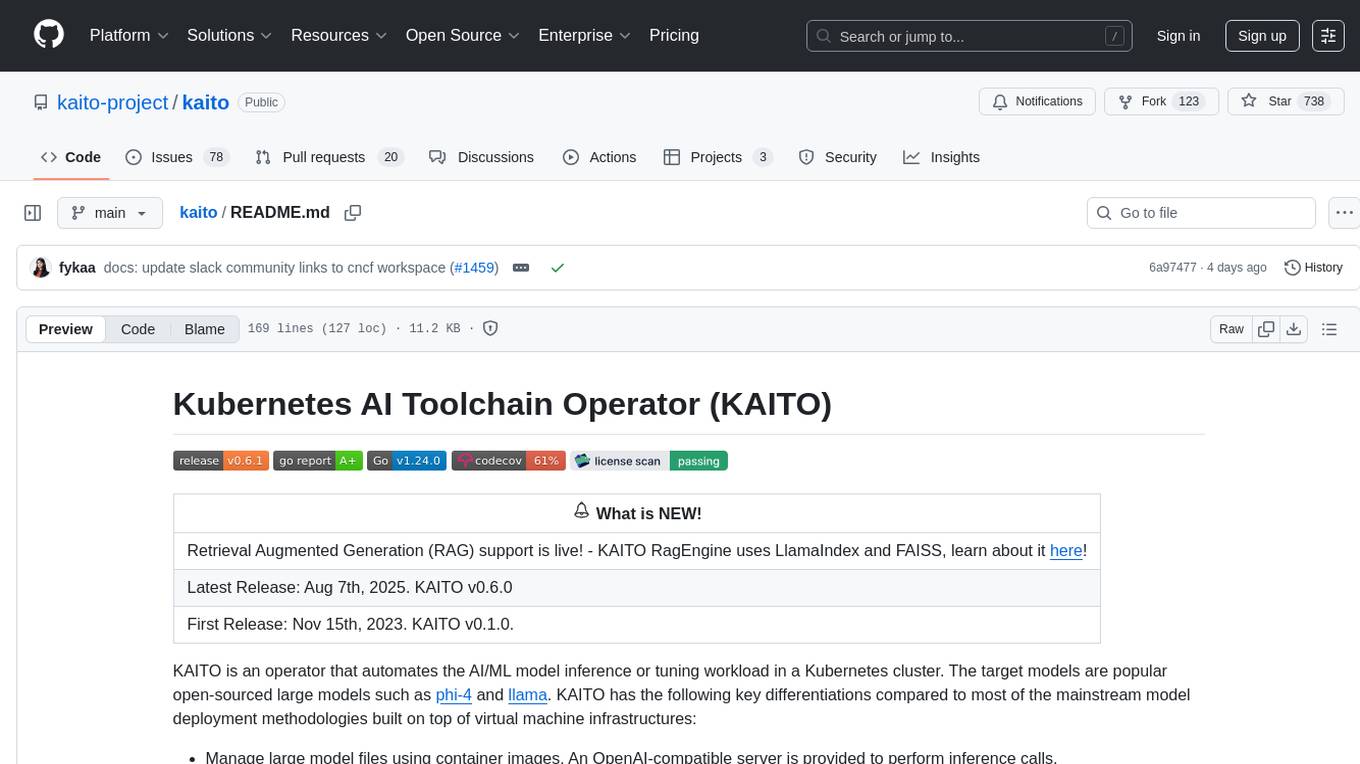
kaito
KAITO is an operator that automates the AI/ML model inference or tuning workload in a Kubernetes cluster. It manages large model files using container images, provides preset configurations to avoid adjusting workload parameters based on GPU hardware, supports popular open-sourced inference runtimes, auto-provisions GPU nodes based on model requirements, and hosts large model images in the public Microsoft Container Registry. Using KAITO simplifies the workflow of onboarding large AI inference models in Kubernetes.
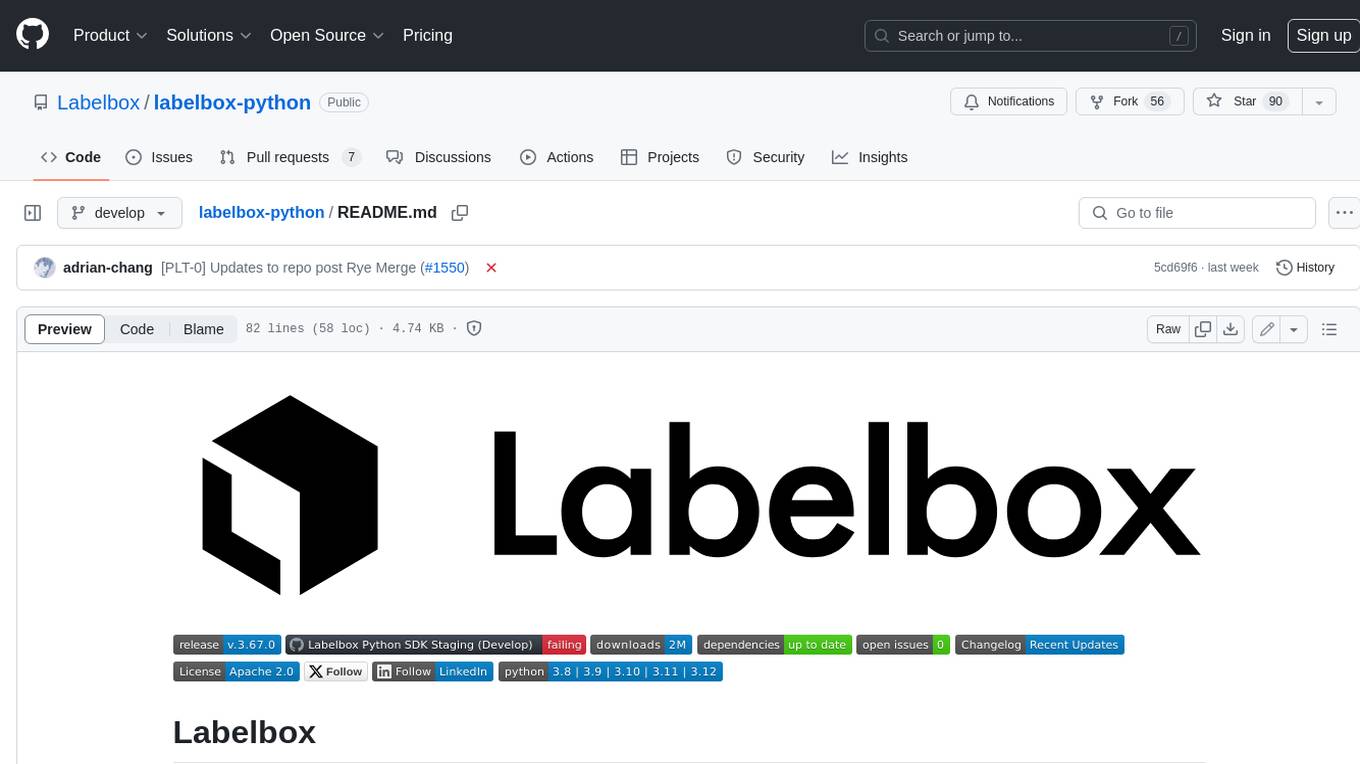
labelbox-python
Labelbox is a data-centric AI platform for enterprises to develop, optimize, and use AI to solve problems and power new products and services. Enterprises use Labelbox to curate data, generate high-quality human feedback data for computer vision and LLMs, evaluate model performance, and automate tasks by combining AI and human-centric workflows. The academic & research community uses Labelbox for cutting-edge AI research.
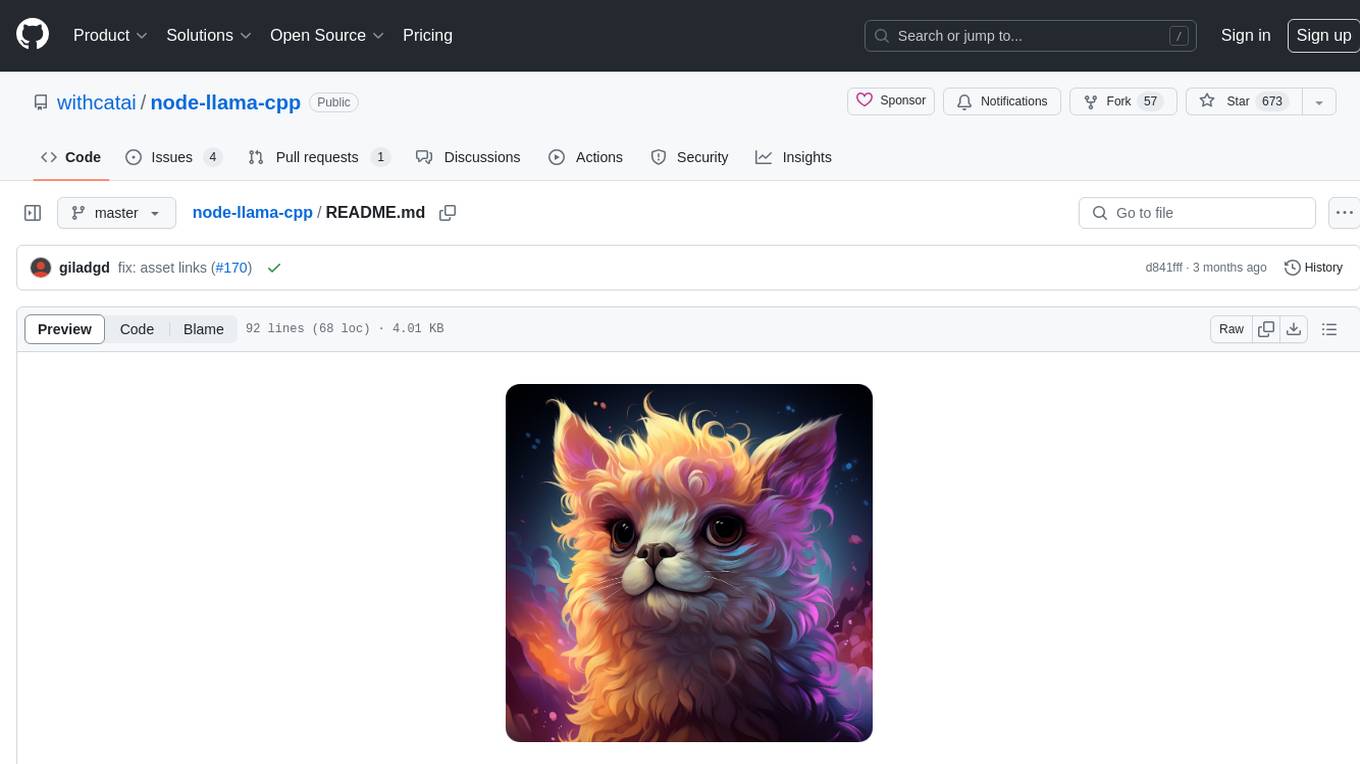
node-llama-cpp
node-llama-cpp is a tool that allows users to run AI models locally on their machines. It provides pre-built bindings with the option to build from source using cmake. Users can interact with text generation models, chat with models using a chat wrapper, and force models to generate output in a parseable format like JSON. The tool supports Metal and CUDA, offers CLI functionality for chatting with models without coding, and ensures up-to-date compatibility with the latest version of llama.cpp. Installation includes pre-built binaries for macOS, Linux, and Windows, with the option to build from source if binaries are not available for the platform.
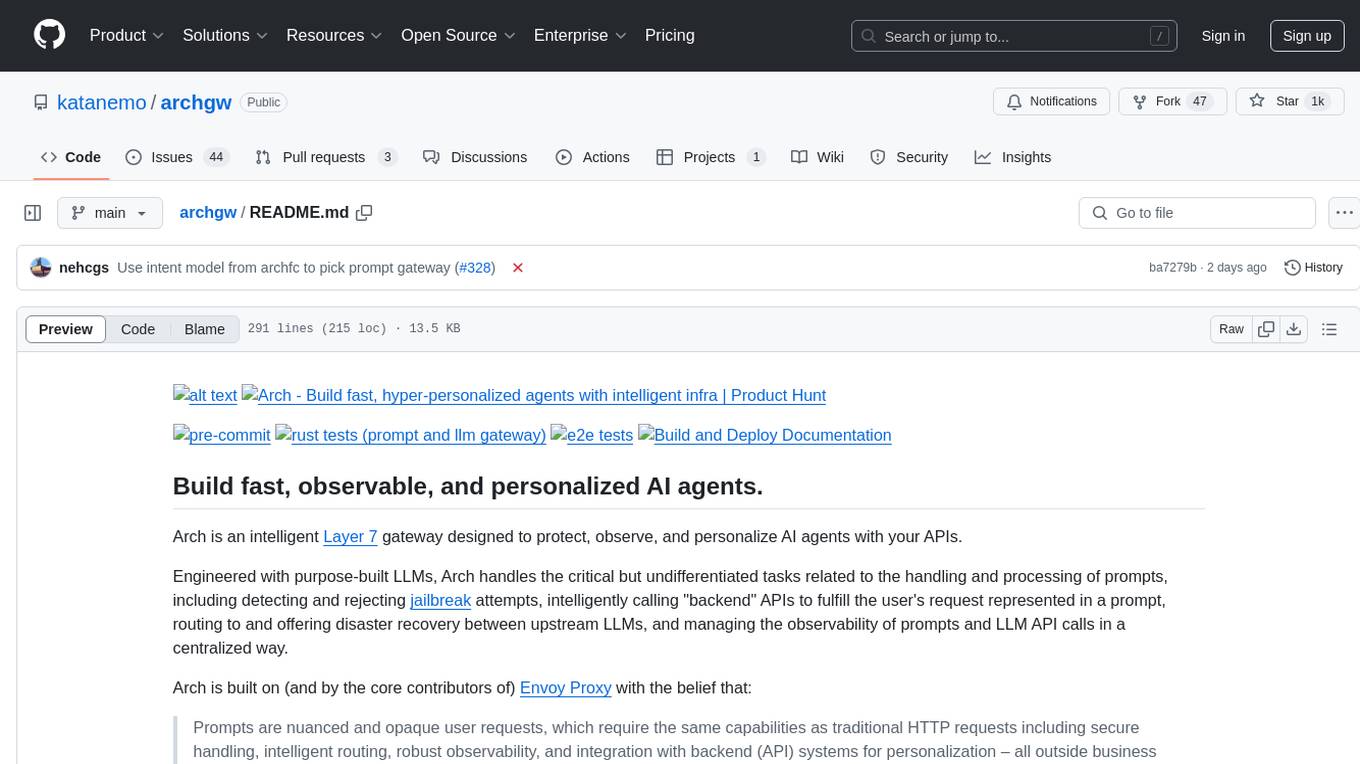
archgw
Arch is an intelligent Layer 7 gateway designed to protect, observe, and personalize AI agents with APIs. It handles tasks related to prompts, including detecting jailbreak attempts, calling backend APIs, routing between LLMs, and managing observability. Built on Envoy Proxy, it offers features like function calling, prompt guardrails, traffic management, and observability. Users can build fast, observable, and personalized AI agents using Arch to improve speed, security, and personalization of GenAI apps.

raglite
RAGLite is a Python toolkit for Retrieval-Augmented Generation (RAG) with PostgreSQL or SQLite. It offers configurable options for choosing LLM providers, database types, and rerankers. The toolkit is fast and permissive, utilizing lightweight dependencies and hardware acceleration. RAGLite provides features like PDF to Markdown conversion, multi-vector chunk embedding, optimal semantic chunking, hybrid search capabilities, adaptive retrieval, and improved output quality. It is extensible with a built-in Model Context Protocol server, customizable ChatGPT-like frontend, document conversion to Markdown, and evaluation tools. Users can configure RAGLite for various tasks like configuring, inserting documents, running RAG pipelines, computing query adapters, evaluating performance, running MCP servers, and serving frontends.
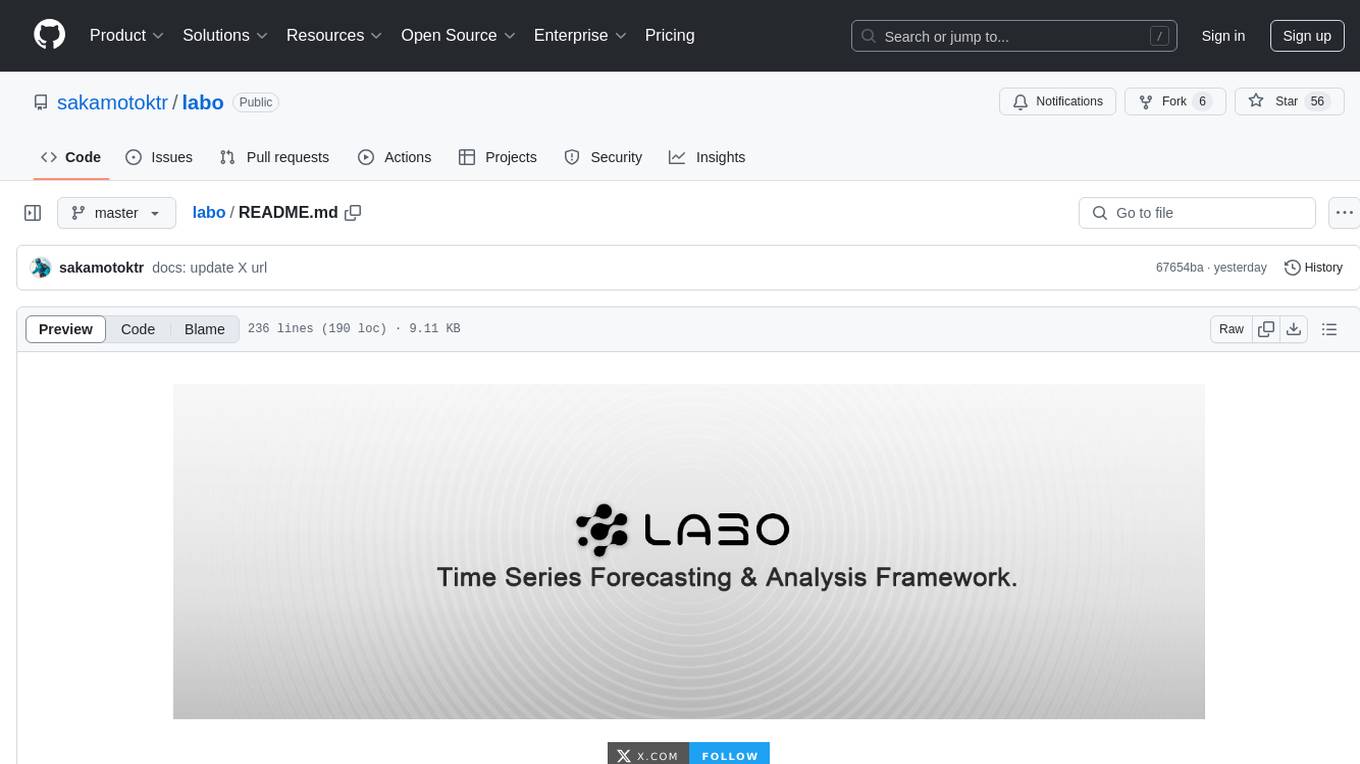
labo
LABO is a time series forecasting and analysis framework that integrates pre-trained and fine-tuned LLMs with multi-domain agent-based systems. It allows users to create and tune agents easily for various scenarios, such as stock market trend prediction and web public opinion analysis. LABO requires a specific runtime environment setup, including system requirements, Python environment, dependency installations, and configurations. Users can fine-tune their own models using LABO's Low-Rank Adaptation (LoRA) for computational efficiency and continuous model updates. Additionally, LABO provides a Python library for building model training pipelines and customizing agents for specific tasks.
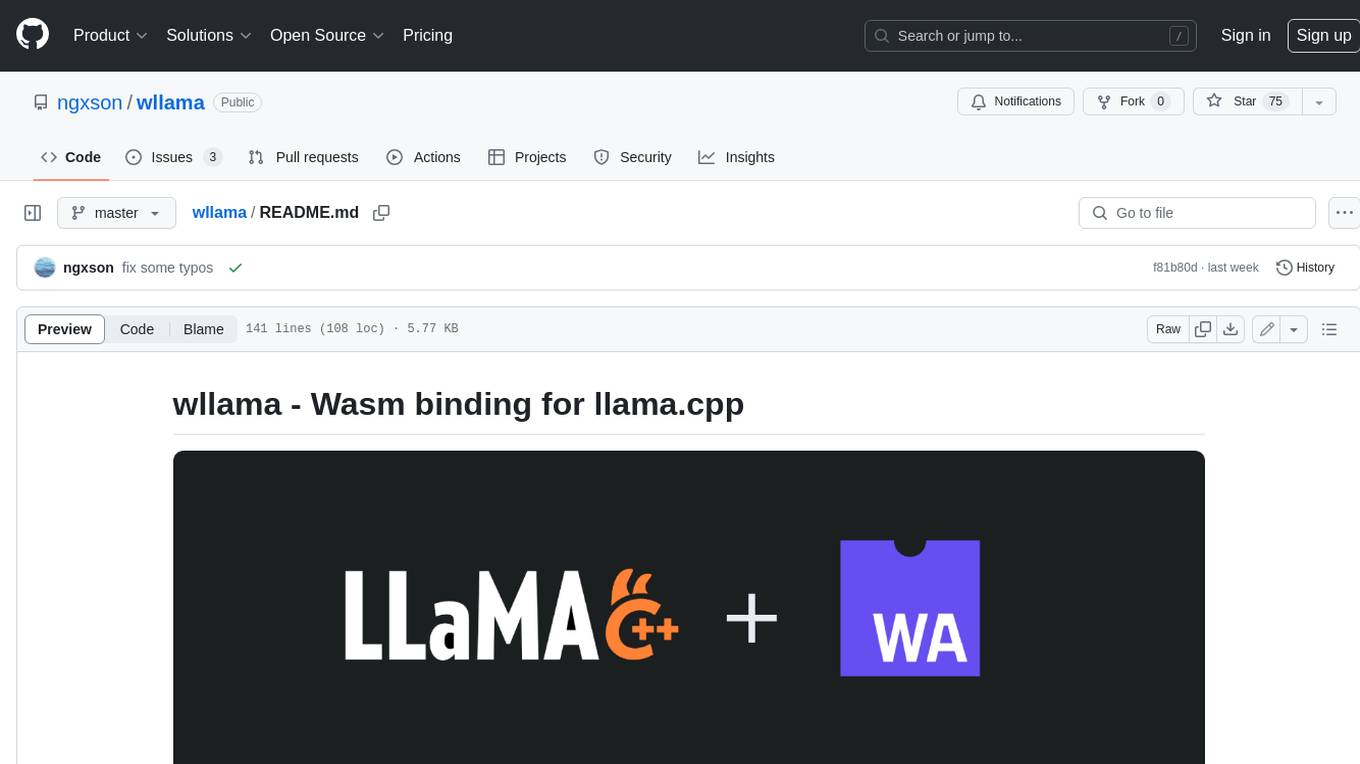
wllama
Wllama is a WebAssembly binding for llama.cpp, a high-performance and lightweight language model library. It enables you to run inference directly on the browser without the need for a backend or GPU. Wllama provides both high-level and low-level APIs, allowing you to perform various tasks such as completions, embeddings, tokenization, and more. It also supports model splitting, enabling you to load large models in parallel for faster download. With its Typescript support and pre-built npm package, Wllama is easy to integrate into your React Typescript projects.
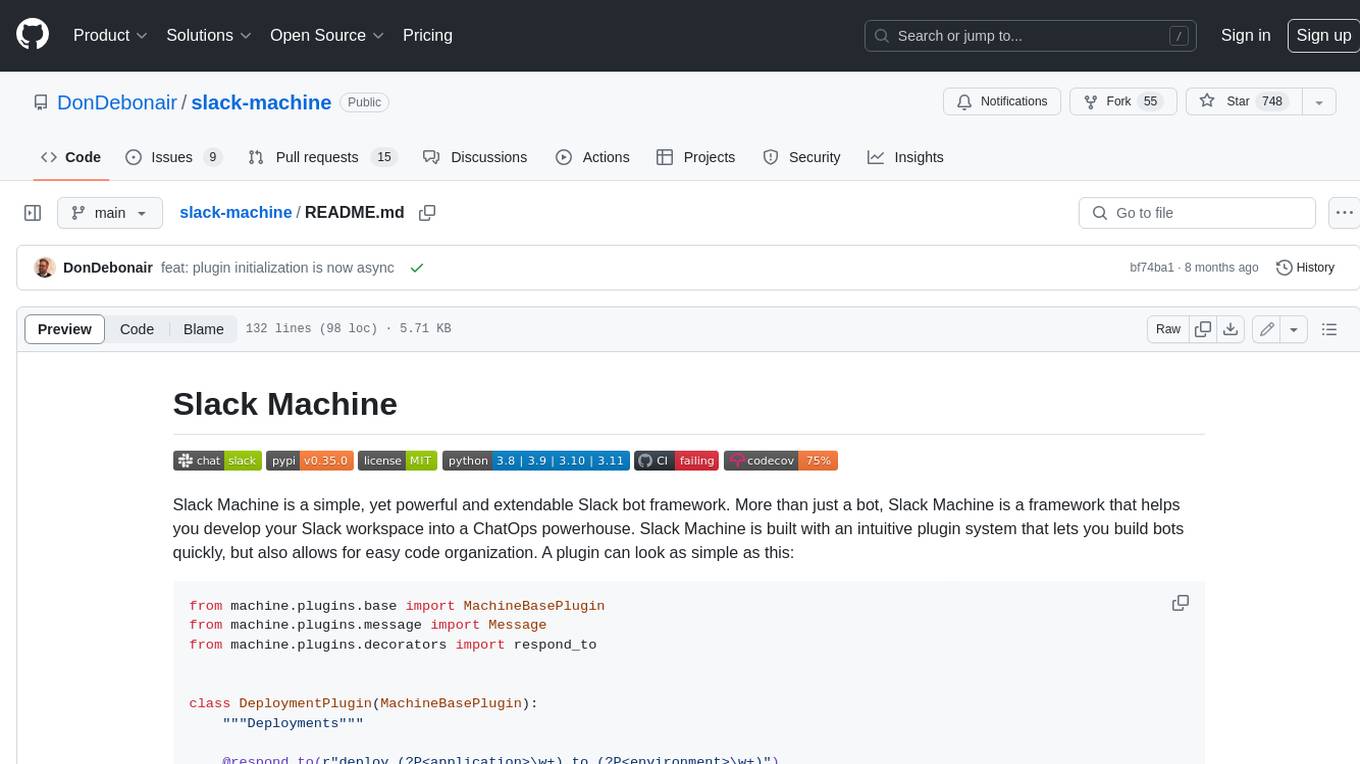
slack-machine
Slack Machine is a simple, yet powerful and extendable Slack bot framework. More than just a bot, Slack Machine is a framework that helps you develop your Slack workspace into a ChatOps powerhouse. Slack Machine is built with an intuitive plugin system that lets you build bots quickly, but also allows for easy code organization.
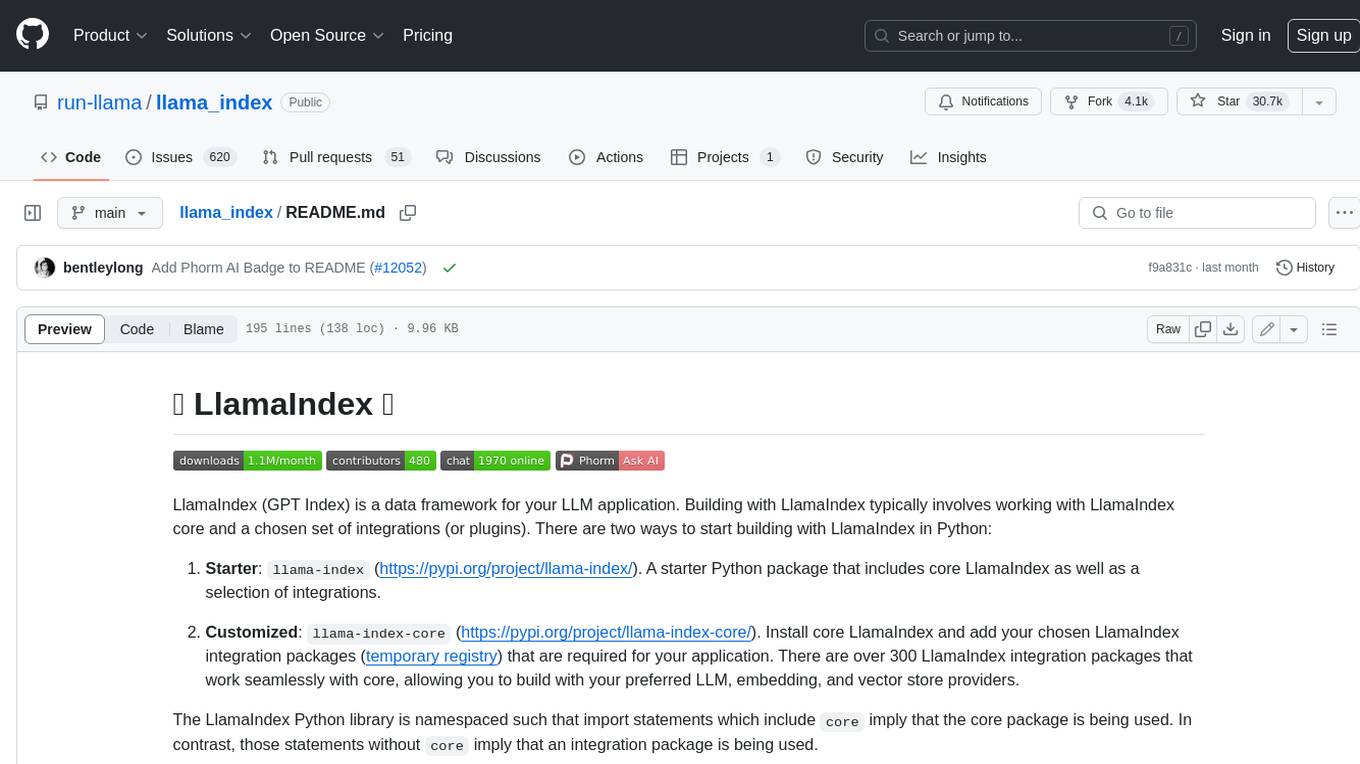
llama_index
LlamaIndex is a data framework for building LLM applications. It provides tools for ingesting, structuring, and querying data, as well as integrating with LLMs and other tools. LlamaIndex is designed to be easy to use for both beginner and advanced users, and it provides a comprehensive set of features for building LLM applications.
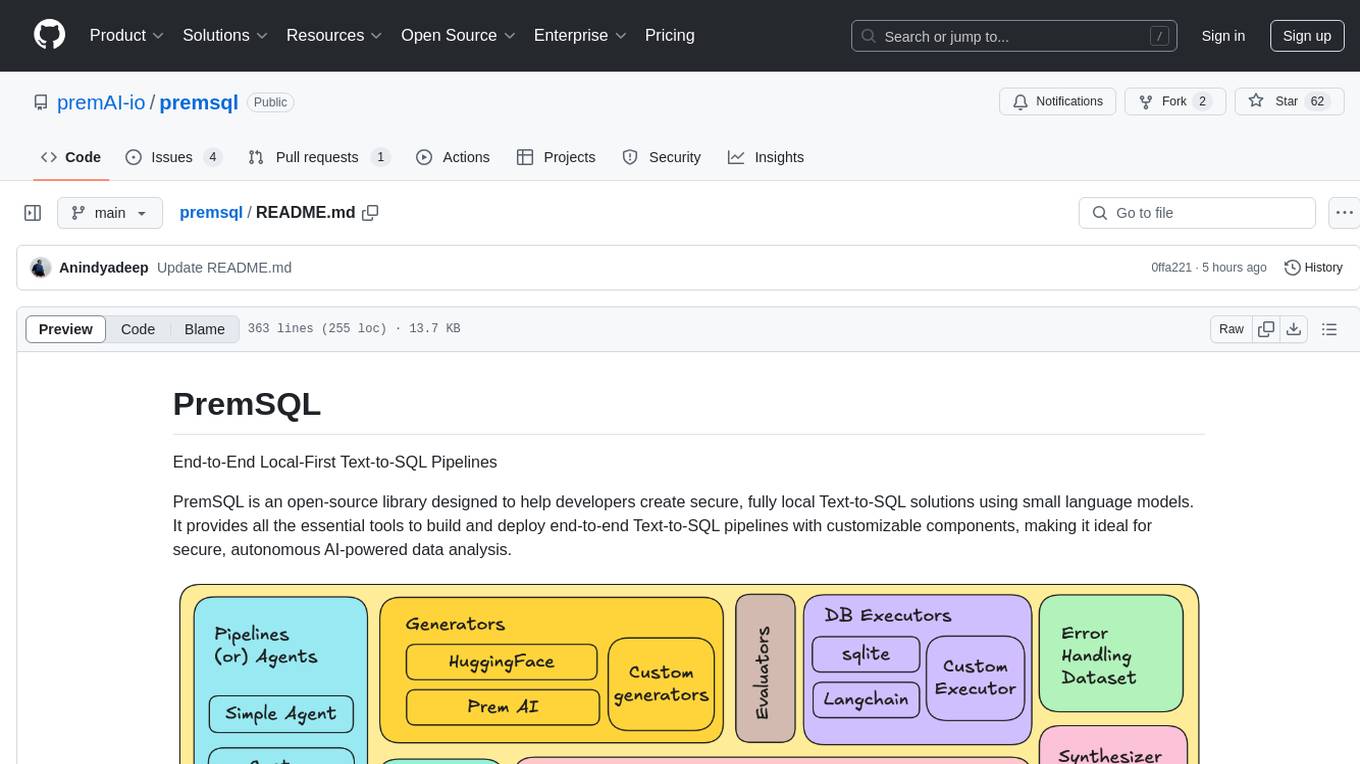
premsql
PremSQL is an open-source library designed to help developers create secure, fully local Text-to-SQL solutions using small language models. It provides essential tools for building and deploying end-to-end Text-to-SQL pipelines with customizable components, ideal for secure, autonomous AI-powered data analysis. The library offers features like Local-First approach, Customizable Datasets, Robust Executors and Evaluators, Advanced Generators, Error Handling and Self-Correction, Fine-Tuning Support, and End-to-End Pipelines. Users can fine-tune models, generate SQL queries from natural language inputs, handle errors, and evaluate model performance against predefined metrics. PremSQL is extendible for customization and private data usage.
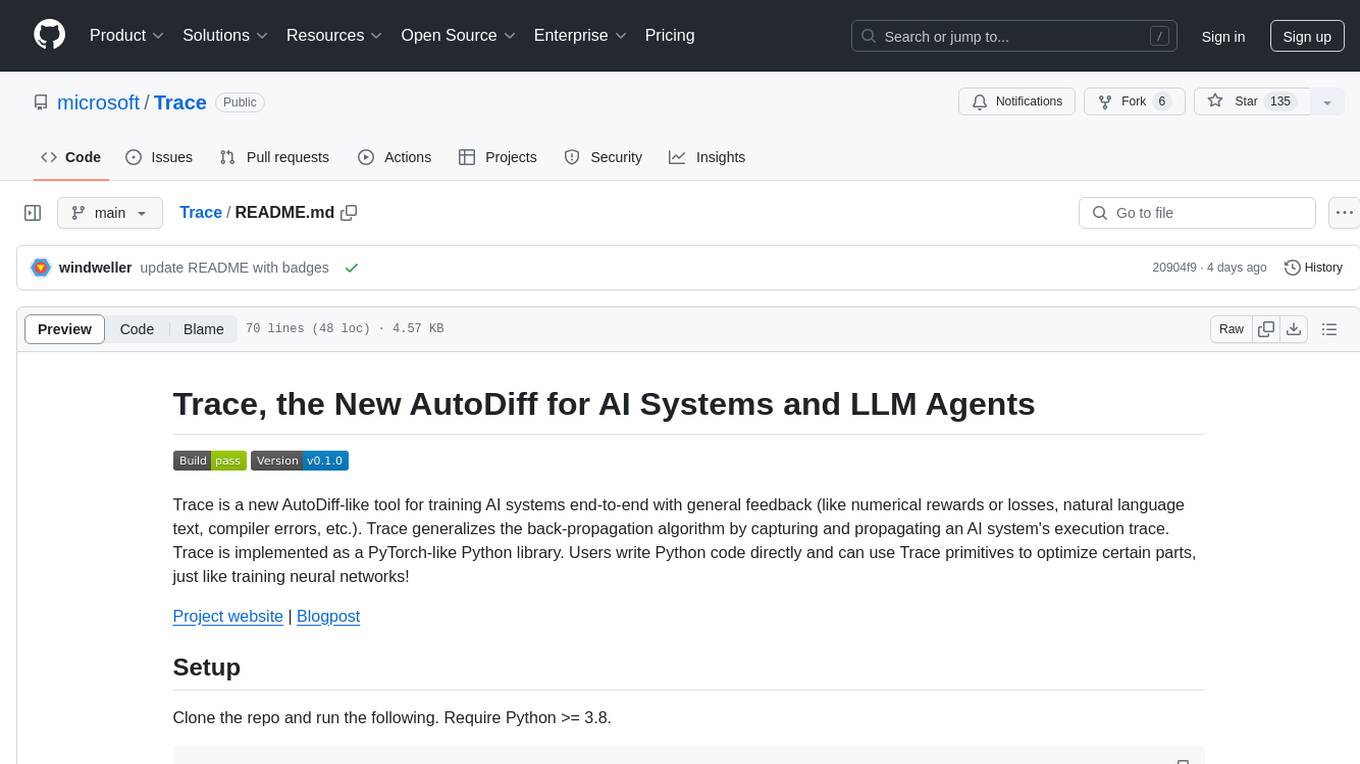
Trace
Trace is a new AutoDiff-like tool for training AI systems end-to-end with general feedback. It generalizes the back-propagation algorithm by capturing and propagating an AI system's execution trace. Implemented as a PyTorch-like Python library, users can write Python code directly and use Trace primitives to optimize certain parts, similar to training neural networks.
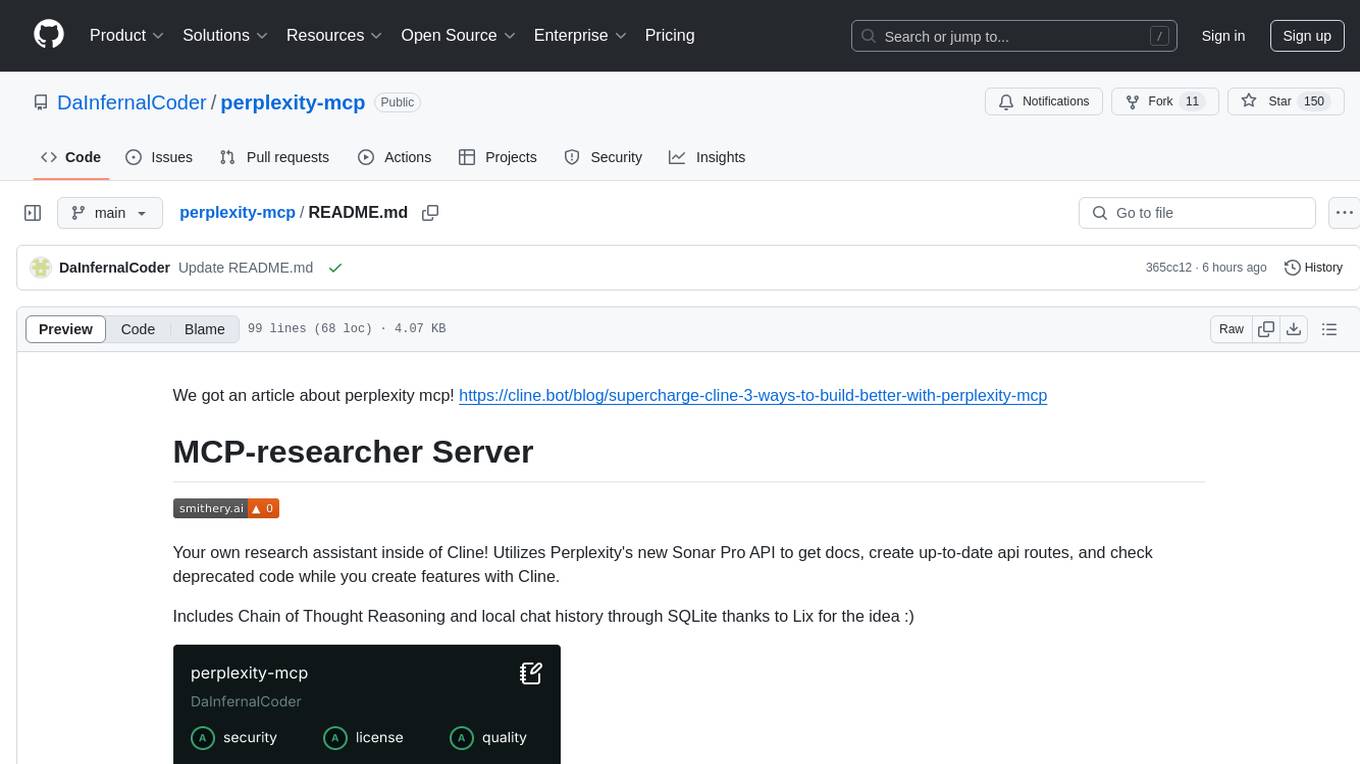
perplexity-mcp
MCP-researcher Server is a tool that serves as your research assistant inside Cline, utilizing Perplexity's Sonar Pro API to access documentation, create API routes, and check for deprecated code. It includes Chain of Thought Reasoning and local chat history through SQLite. The tool offers functionalities like general search queries, retrieving documentation, finding APIs, and analyzing deprecated code. Installation can be done via Smithery or manually by cloning the repository, installing dependencies, and setting up the Perplexity API key and server configurations for Claude Desktop and Cline.
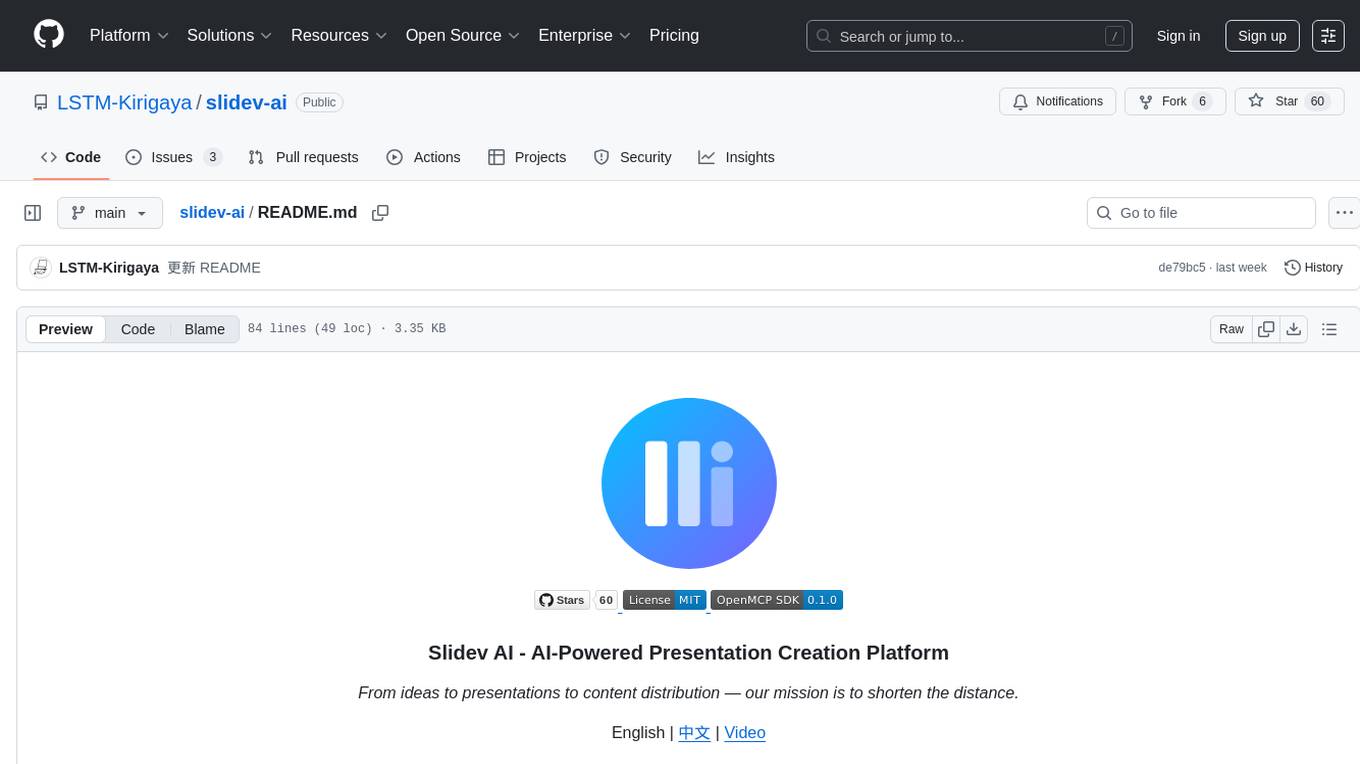
slidev-ai
Slidev AI is a web app that leverages LLM (Large Language Model) technology to make creating Slidev-based online presentations elegant and effortless. It is designed to help engineers and academics quickly produce content-focused, minimalist PPTs that are easily shareable online. This project serves as a reference implementation for OpenMCP agent development, a production-ready presentation generation solution, and a template for creating domain-specific AI agents.
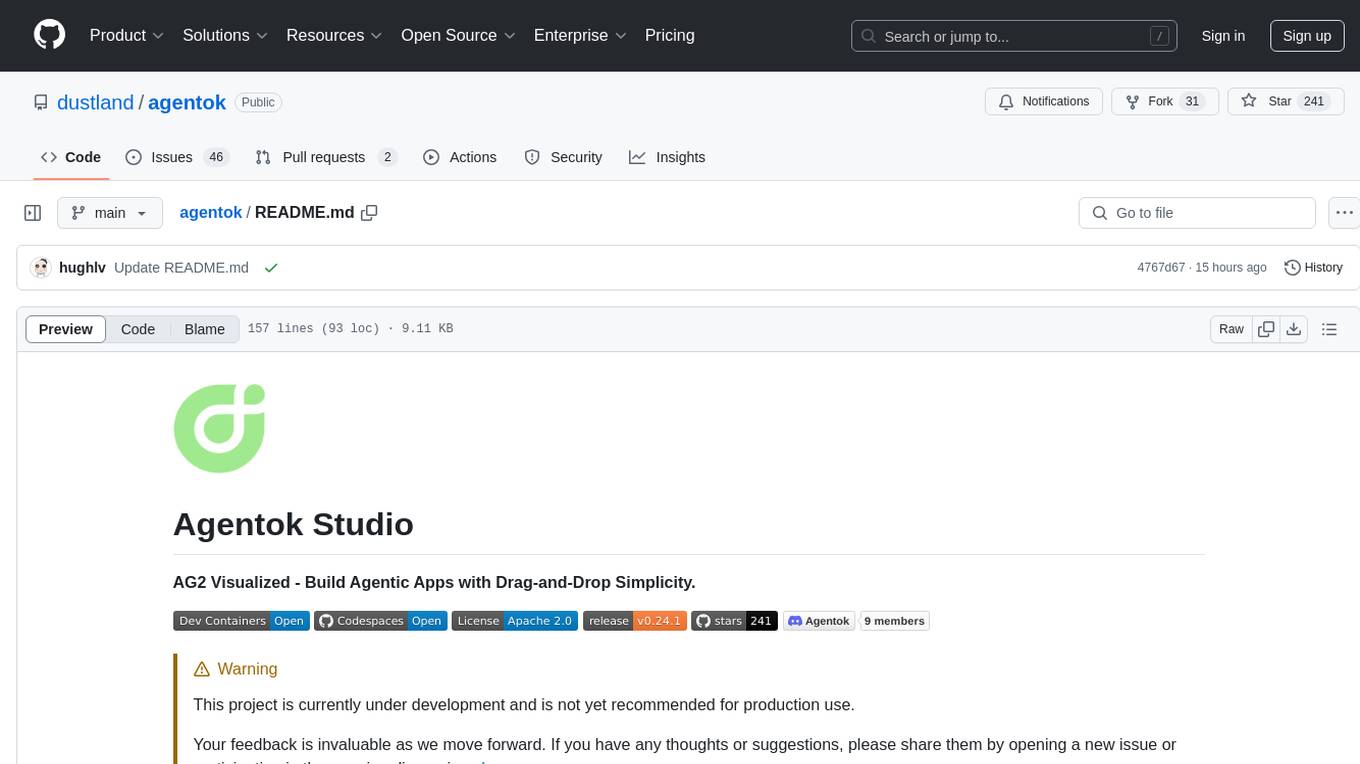
agentok
Agentok Studio is a tool built upon AG2, a powerful agent framework from Microsoft, offering intuitive visual tools to streamline the creation and management of complex agent-based workflows. It simplifies the process for creators and developers by generating native Python code with minimal dependencies, enabling users to create self-contained code that can be executed anywhere. The tool is currently under development and not recommended for production use, but contributions are welcome from the community to enhance its capabilities and functionalities.
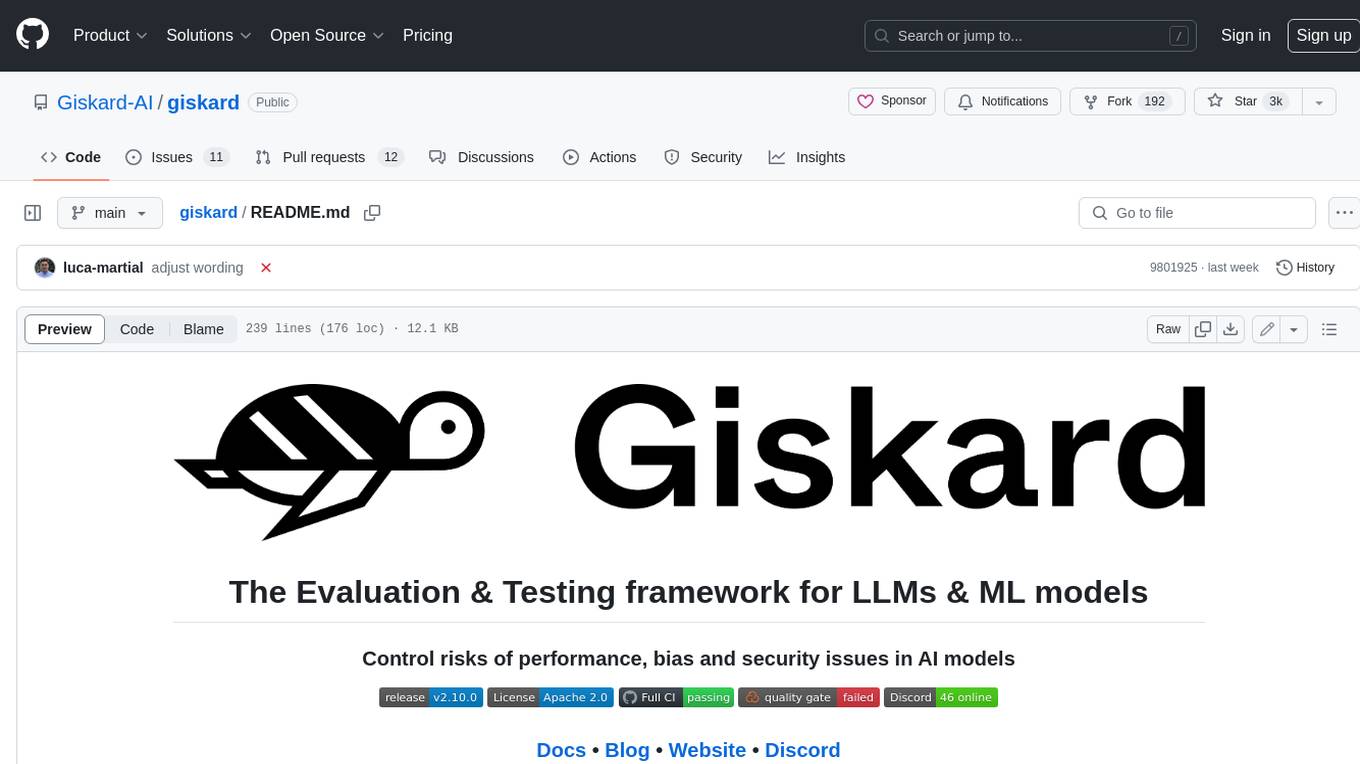
giskard
Giskard is an open-source Python library that automatically detects performance, bias & security issues in AI applications. The library covers LLM-based applications such as RAG agents, all the way to traditional ML models for tabular data.
For similar tasks
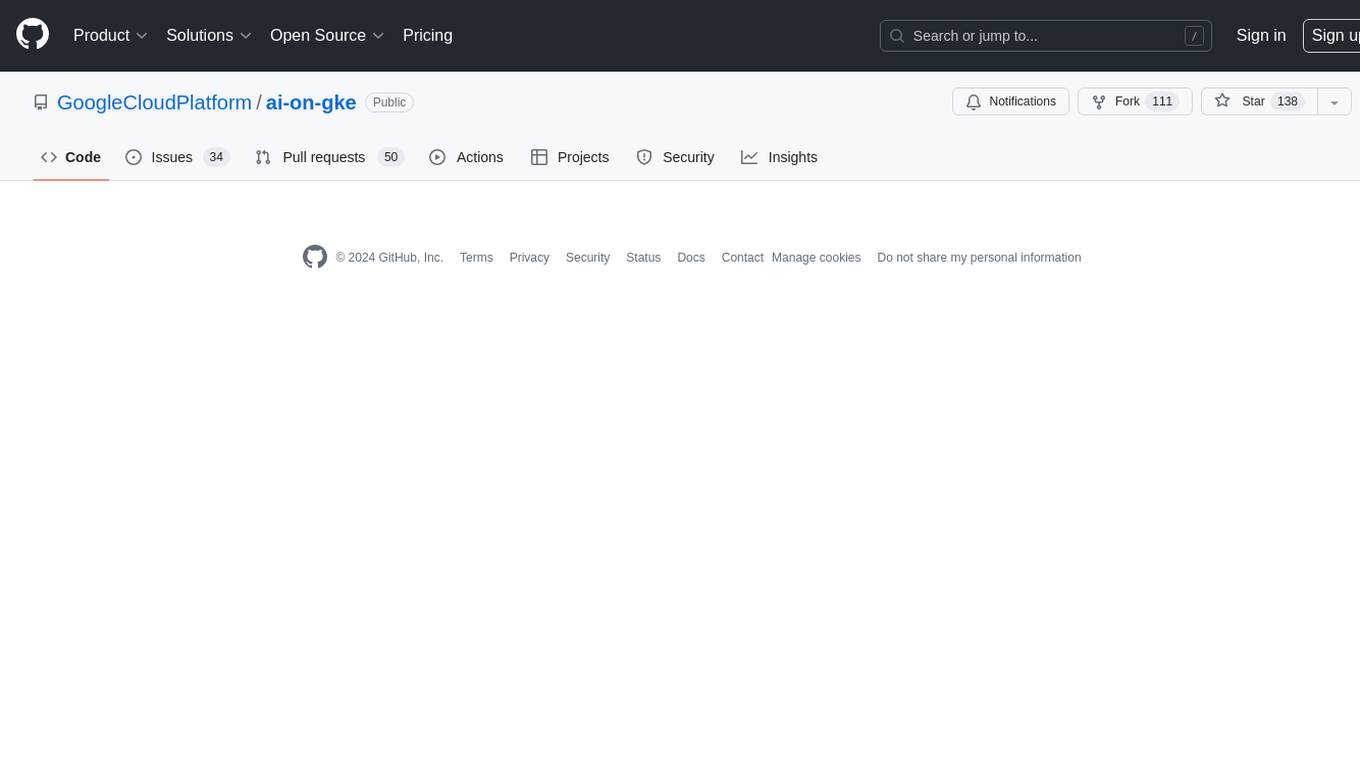
ai-on-gke
This repository contains assets related to AI/ML workloads on Google Kubernetes Engine (GKE). Run optimized AI/ML workloads with Google Kubernetes Engine (GKE) platform orchestration capabilities. A robust AI/ML platform considers the following layers: Infrastructure orchestration that support GPUs and TPUs for training and serving workloads at scale Flexible integration with distributed computing and data processing frameworks Support for multiple teams on the same infrastructure to maximize utilization of resources
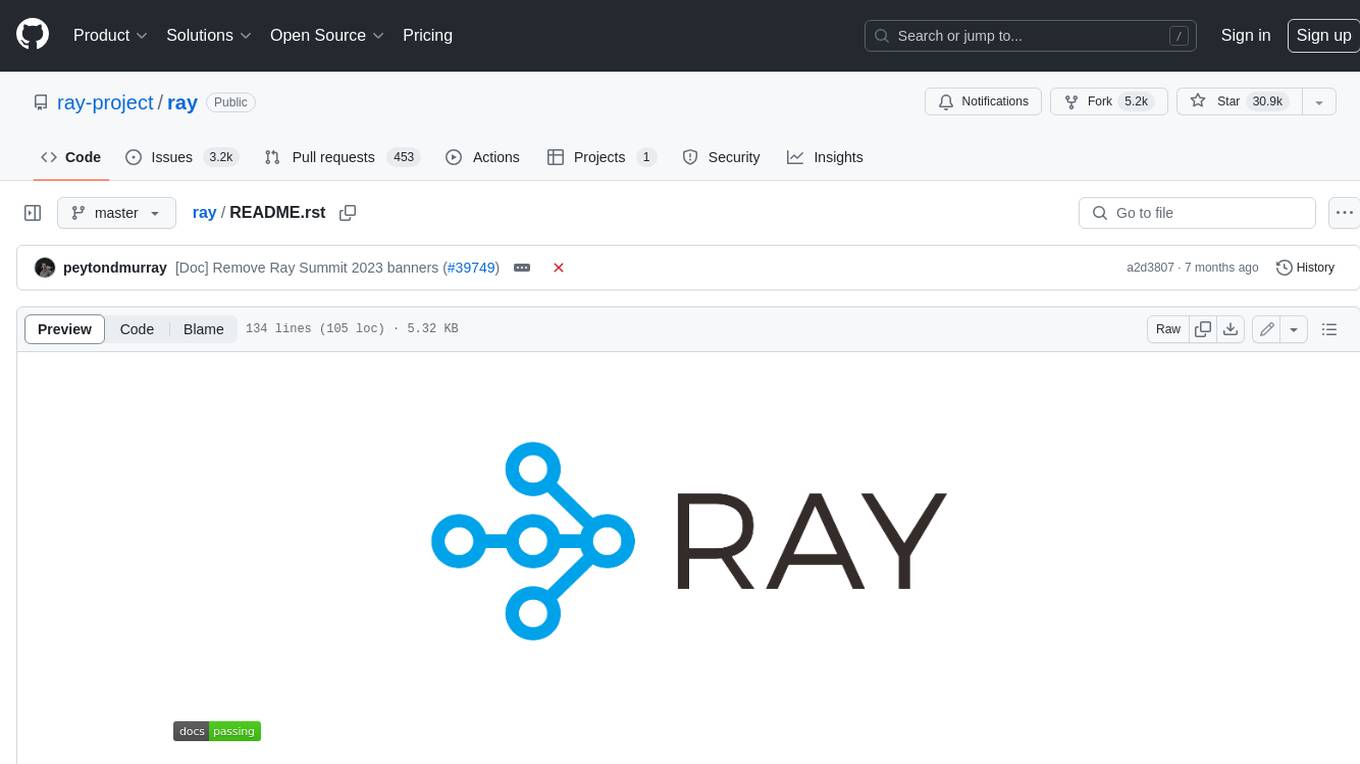
ray
Ray is a unified framework for scaling AI and Python applications. It consists of a core distributed runtime and a set of AI libraries for simplifying ML compute, including Data, Train, Tune, RLlib, and Serve. Ray runs on any machine, cluster, cloud provider, and Kubernetes, and features a growing ecosystem of community integrations. With Ray, you can seamlessly scale the same code from a laptop to a cluster, making it easy to meet the compute-intensive demands of modern ML workloads.

labelbox-python
Labelbox is a data-centric AI platform for enterprises to develop, optimize, and use AI to solve problems and power new products and services. Enterprises use Labelbox to curate data, generate high-quality human feedback data for computer vision and LLMs, evaluate model performance, and automate tasks by combining AI and human-centric workflows. The academic & research community uses Labelbox for cutting-edge AI research.
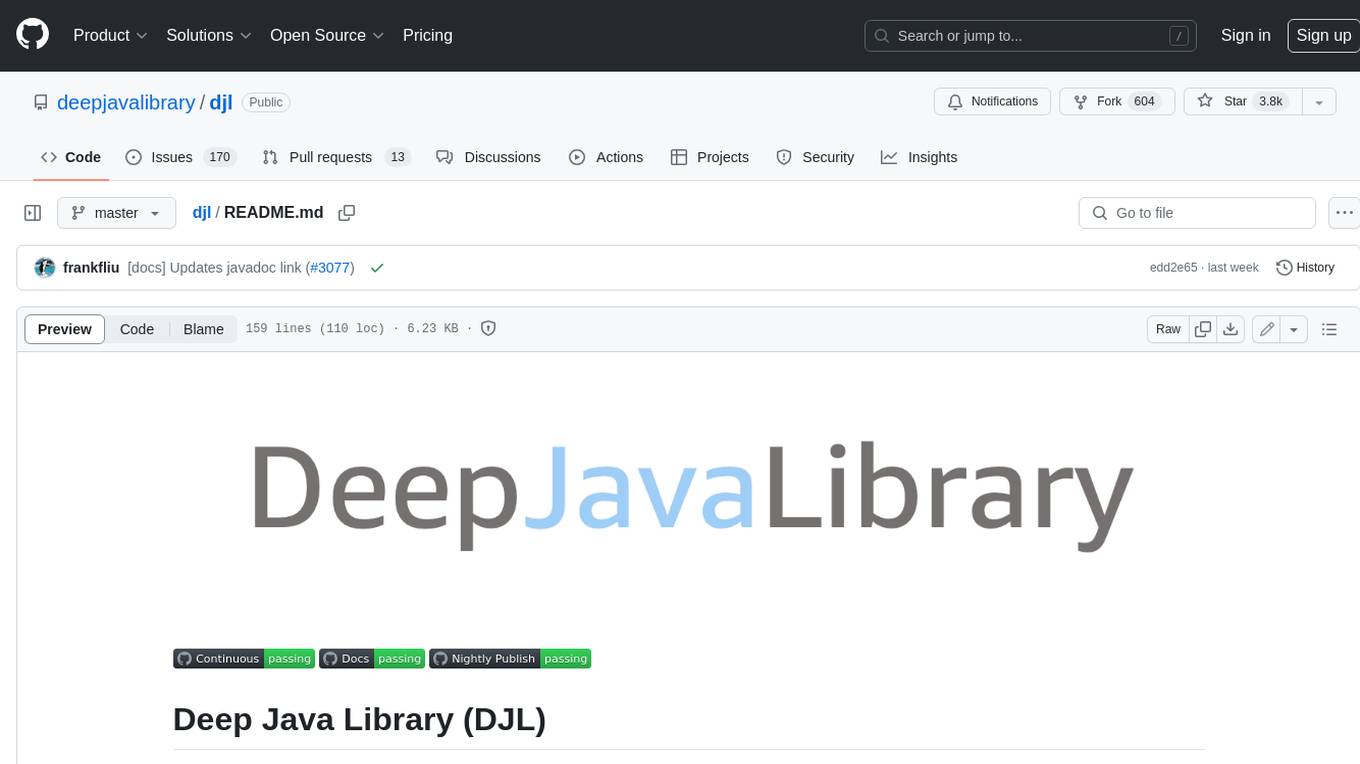
djl
Deep Java Library (DJL) is an open-source, high-level, engine-agnostic Java framework for deep learning. It is designed to be easy to get started with and simple to use for Java developers. DJL provides a native Java development experience and allows users to integrate machine learning and deep learning models with their Java applications. The framework is deep learning engine agnostic, enabling users to switch engines at any point for optimal performance. DJL's ergonomic API interface guides users with best practices to accomplish deep learning tasks, such as running inference and training neural networks.
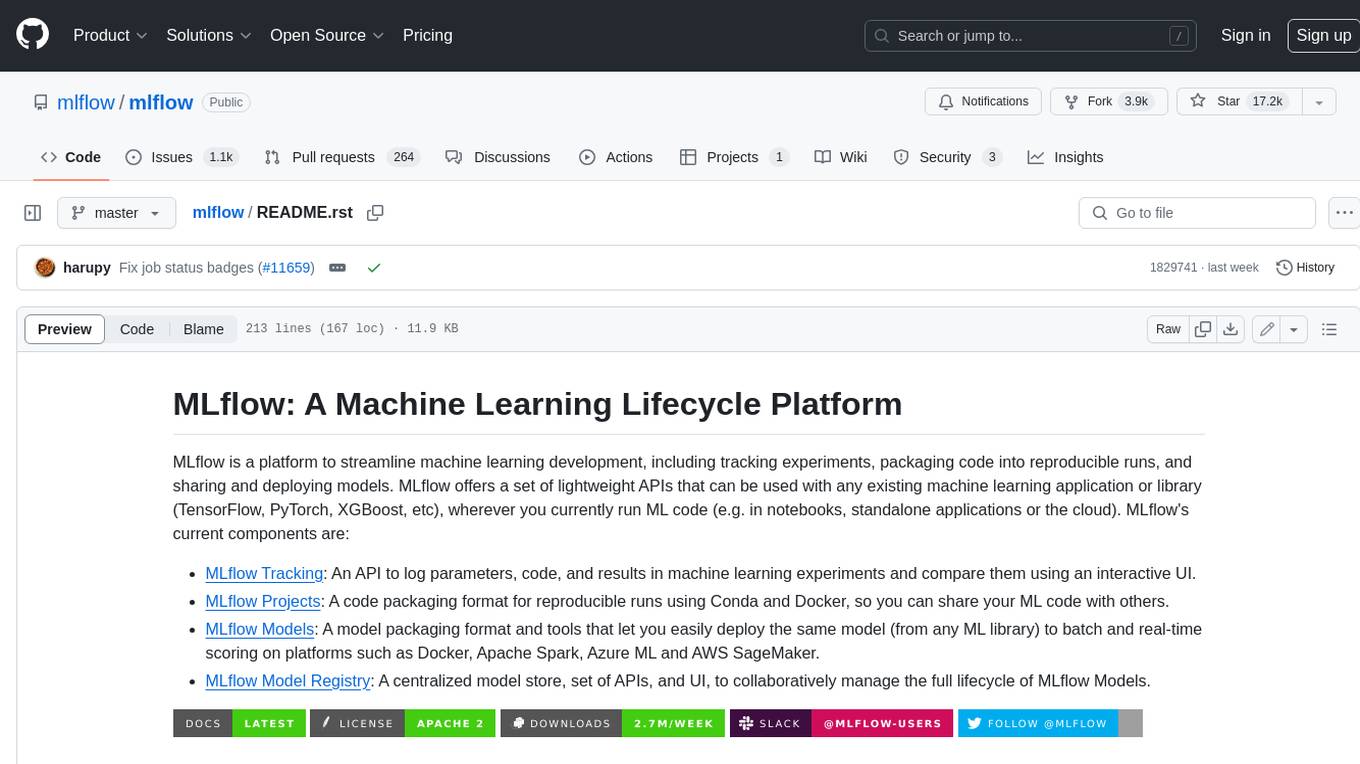
mlflow
MLflow is a platform to streamline machine learning development, including tracking experiments, packaging code into reproducible runs, and sharing and deploying models. MLflow offers a set of lightweight APIs that can be used with any existing machine learning application or library (TensorFlow, PyTorch, XGBoost, etc), wherever you currently run ML code (e.g. in notebooks, standalone applications or the cloud). MLflow's current components are:
* `MLflow Tracking
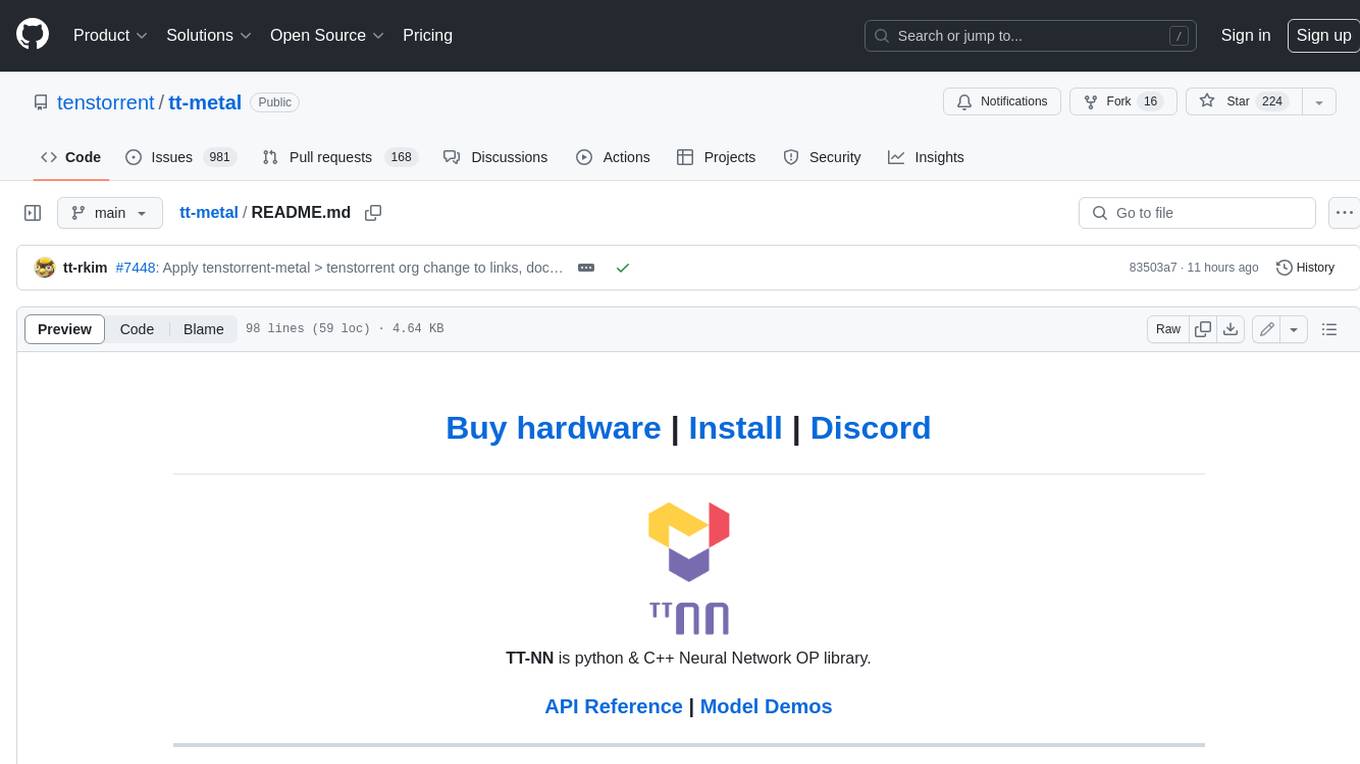
tt-metal
TT-NN is a python & C++ Neural Network OP library. It provides a low-level programming model, TT-Metalium, enabling kernel development for Tenstorrent hardware.
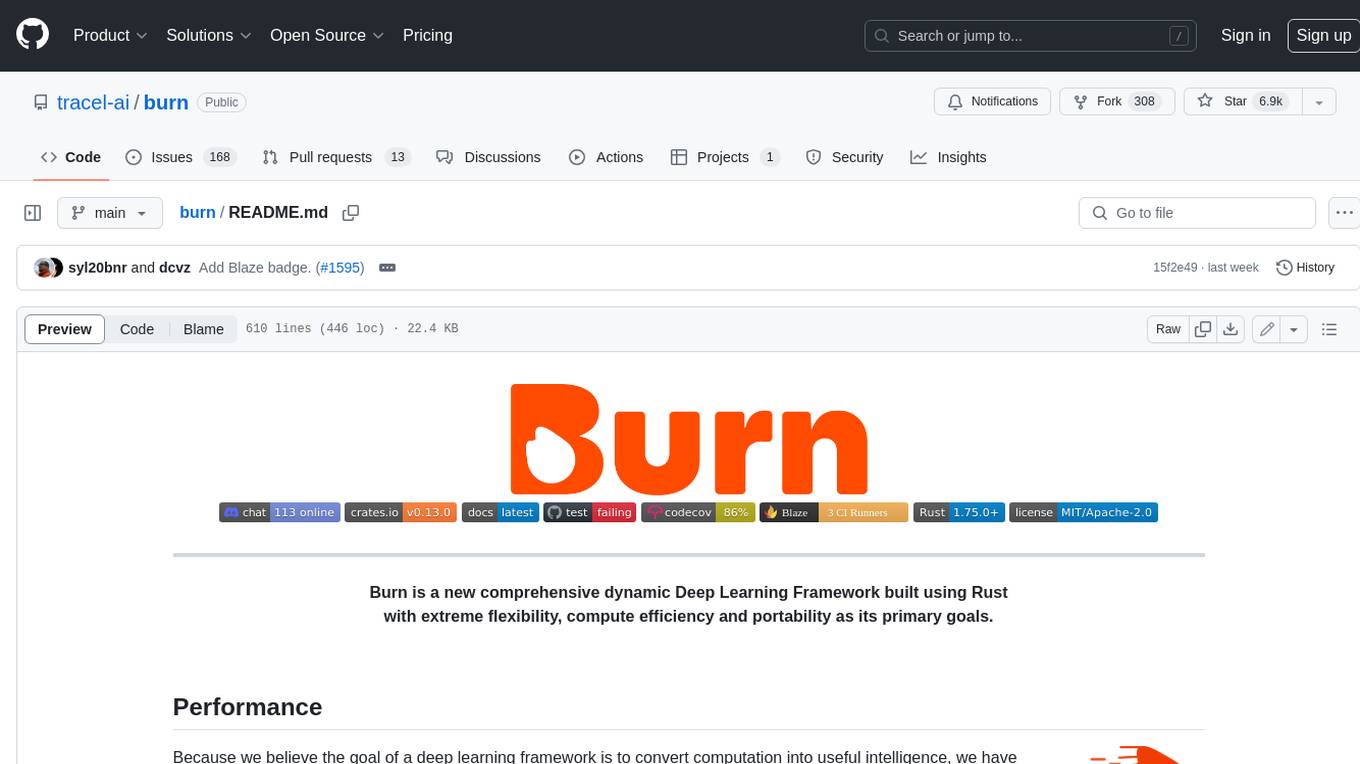
burn
Burn is a new comprehensive dynamic Deep Learning Framework built using Rust with extreme flexibility, compute efficiency and portability as its primary goals.
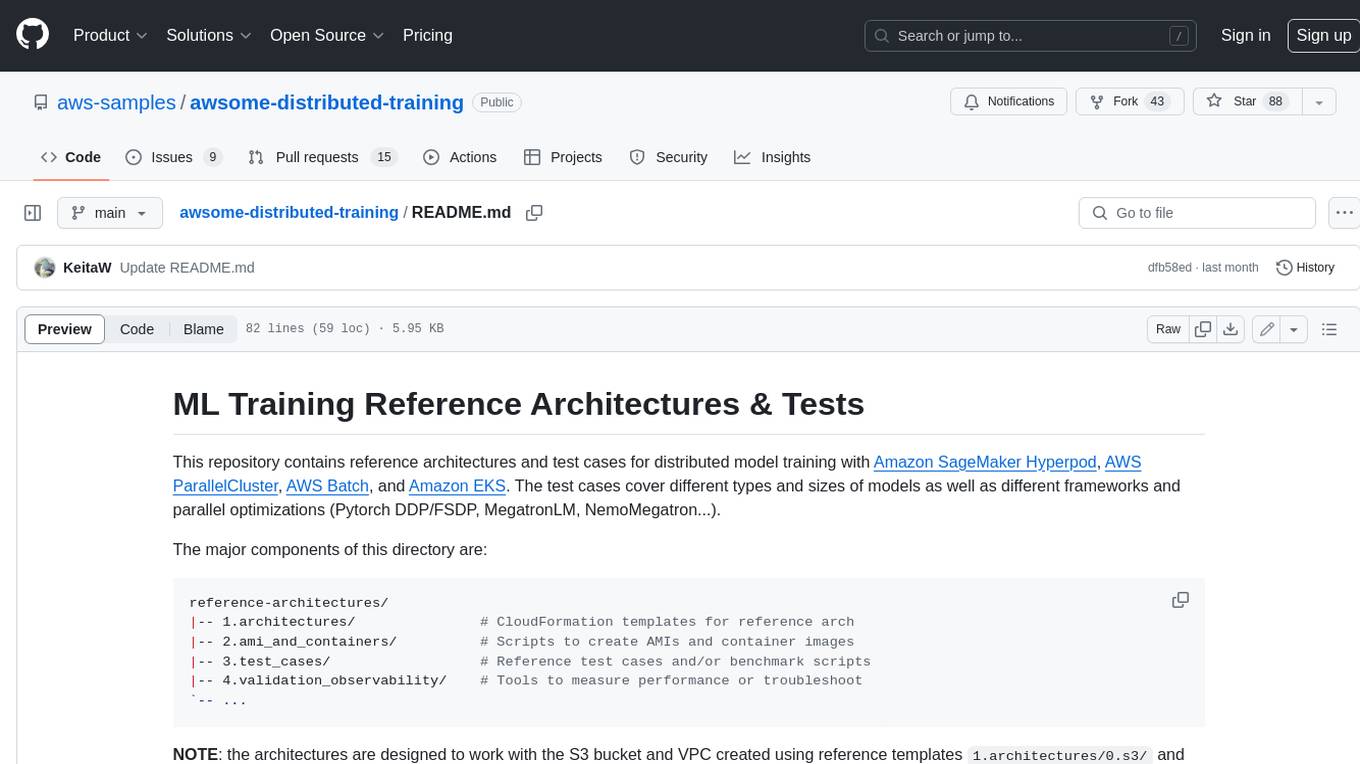
awsome-distributed-training
This repository contains reference architectures and test cases for distributed model training with Amazon SageMaker Hyperpod, AWS ParallelCluster, AWS Batch, and Amazon EKS. The test cases cover different types and sizes of models as well as different frameworks and parallel optimizations (Pytorch DDP/FSDP, MegatronLM, NemoMegatron...).
For similar jobs
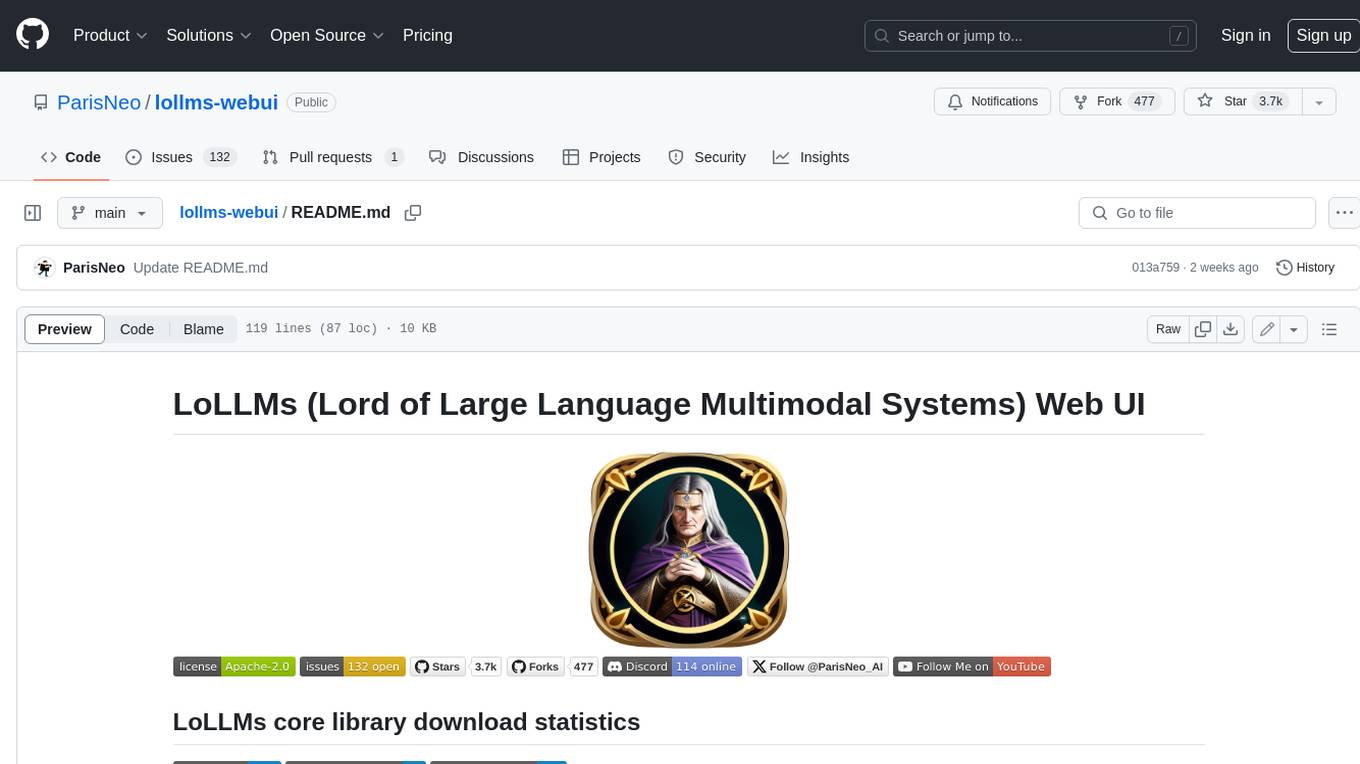
lollms-webui
LoLLMs WebUI (Lord of Large Language Multimodal Systems: One tool to rule them all) is a user-friendly interface to access and utilize various LLM (Large Language Models) and other AI models for a wide range of tasks. With over 500 AI expert conditionings across diverse domains and more than 2500 fine tuned models over multiple domains, LoLLMs WebUI provides an immediate resource for any problem, from car repair to coding assistance, legal matters, medical diagnosis, entertainment, and more. The easy-to-use UI with light and dark mode options, integration with GitHub repository, support for different personalities, and features like thumb up/down rating, copy, edit, and remove messages, local database storage, search, export, and delete multiple discussions, make LoLLMs WebUI a powerful and versatile tool.

Azure-Analytics-and-AI-Engagement
The Azure-Analytics-and-AI-Engagement repository provides packaged Industry Scenario DREAM Demos with ARM templates (Containing a demo web application, Power BI reports, Synapse resources, AML Notebooks etc.) that can be deployed in a customer’s subscription using the CAPE tool within a matter of few hours. Partners can also deploy DREAM Demos in their own subscriptions using DPoC.
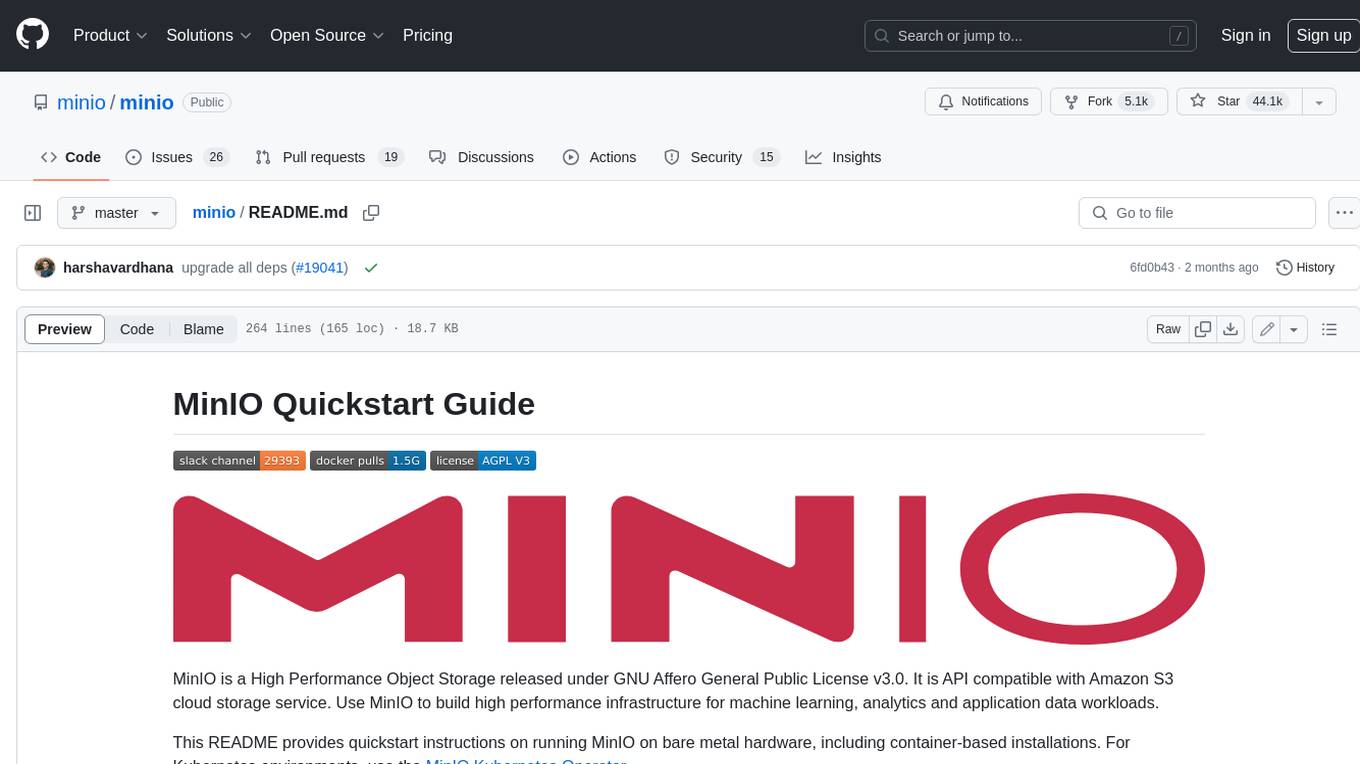
minio
MinIO is a High Performance Object Storage released under GNU Affero General Public License v3.0. It is API compatible with Amazon S3 cloud storage service. Use MinIO to build high performance infrastructure for machine learning, analytics and application data workloads.

mage-ai
Mage is an open-source data pipeline tool for transforming and integrating data. It offers an easy developer experience, engineering best practices built-in, and data as a first-class citizen. Mage makes it easy to build, preview, and launch data pipelines, and provides observability and scaling capabilities. It supports data integrations, streaming pipelines, and dbt integration.
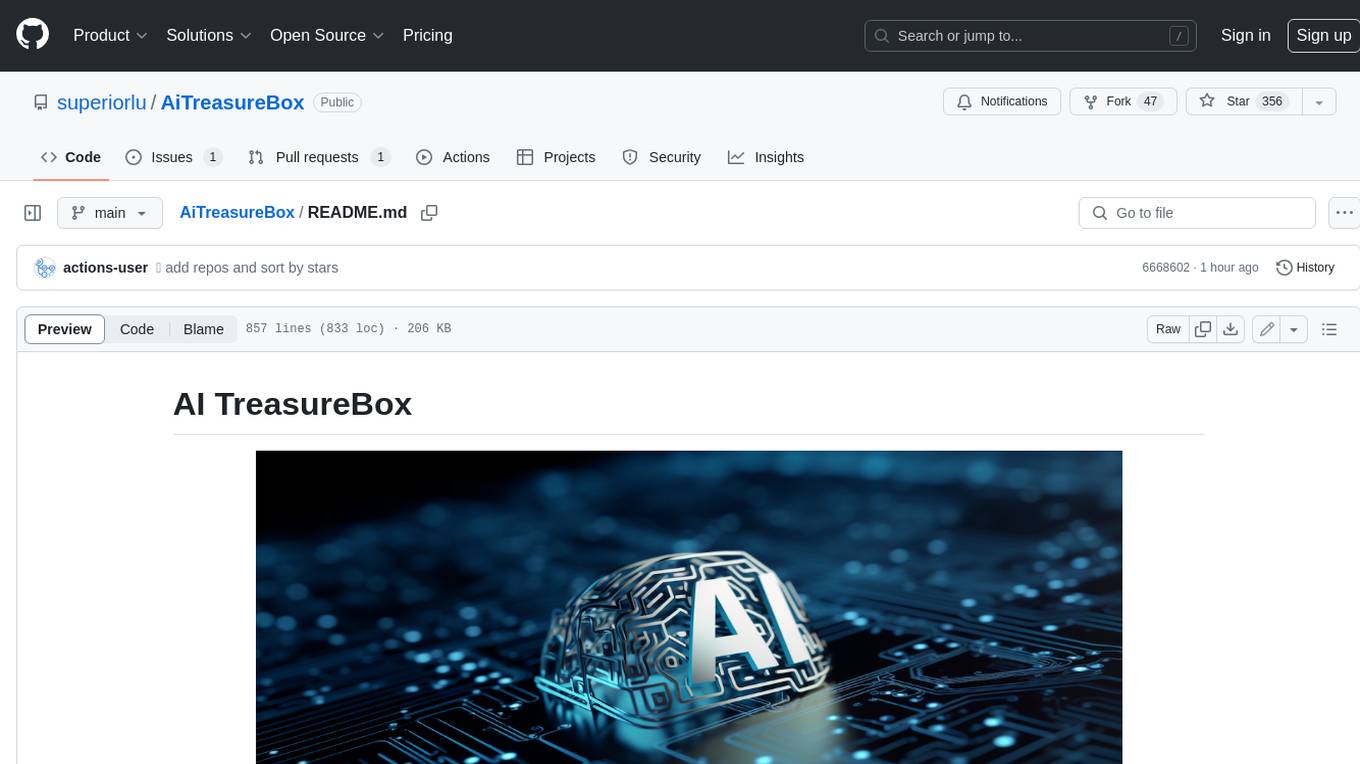
AiTreasureBox
AiTreasureBox is a versatile AI tool that provides a collection of pre-trained models and algorithms for various machine learning tasks. It simplifies the process of implementing AI solutions by offering ready-to-use components that can be easily integrated into projects. With AiTreasureBox, users can quickly prototype and deploy AI applications without the need for extensive knowledge in machine learning or deep learning. The tool covers a wide range of tasks such as image classification, text generation, sentiment analysis, object detection, and more. It is designed to be user-friendly and accessible to both beginners and experienced developers, making AI development more efficient and accessible to a wider audience.
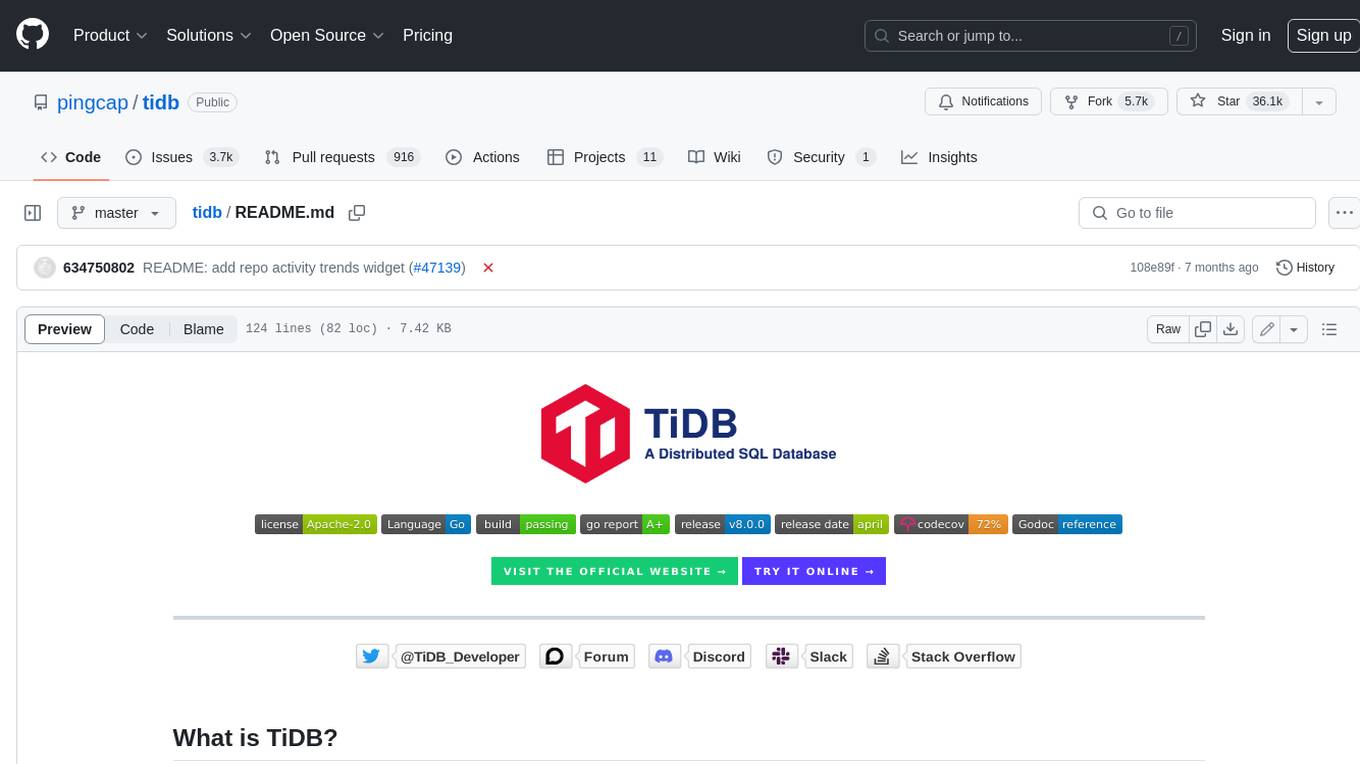
tidb
TiDB is an open-source distributed SQL database that supports Hybrid Transactional and Analytical Processing (HTAP) workloads. It is MySQL compatible and features horizontal scalability, strong consistency, and high availability.
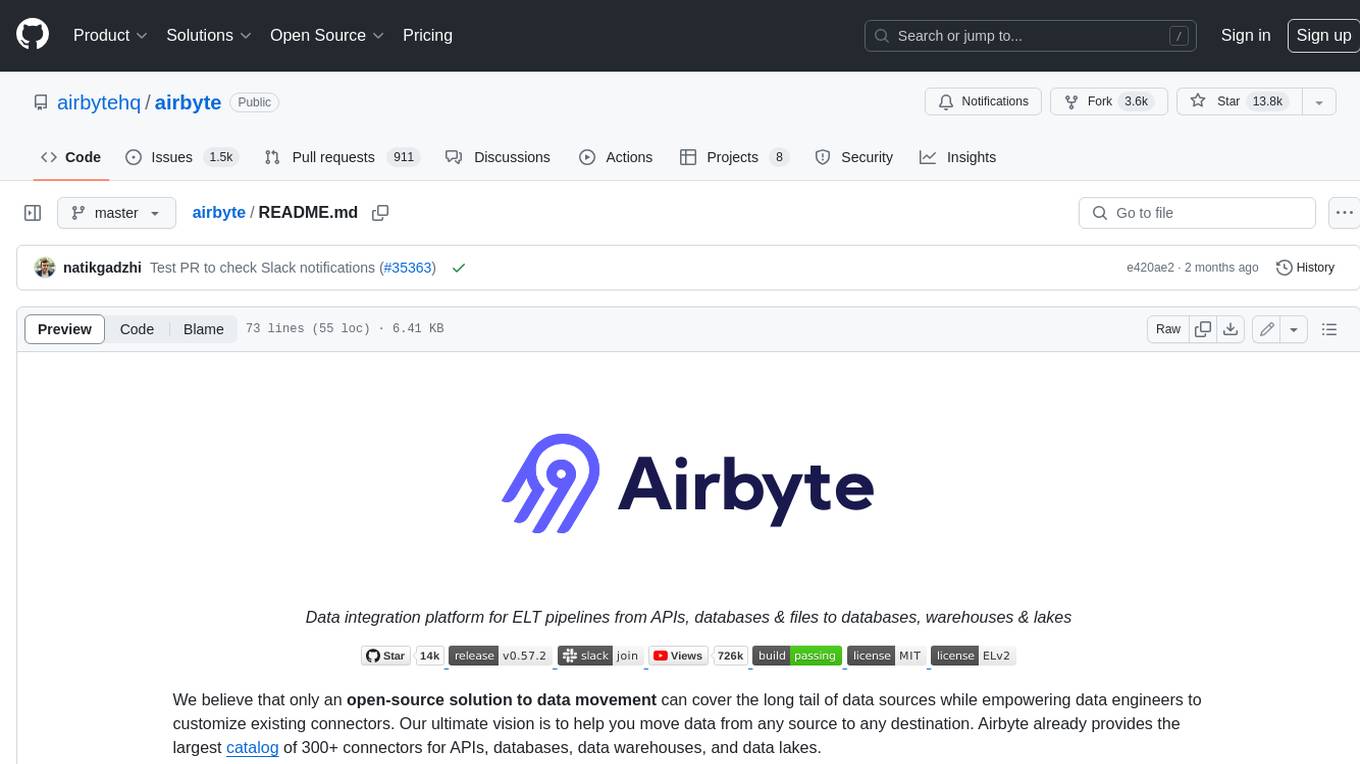
airbyte
Airbyte is an open-source data integration platform that makes it easy to move data from any source to any destination. With Airbyte, you can build and manage data pipelines without writing any code. Airbyte provides a library of pre-built connectors that make it easy to connect to popular data sources and destinations. You can also create your own connectors using Airbyte's no-code Connector Builder or low-code CDK. Airbyte is used by data engineers and analysts at companies of all sizes to build and manage their data pipelines.

labelbox-python
Labelbox is a data-centric AI platform for enterprises to develop, optimize, and use AI to solve problems and power new products and services. Enterprises use Labelbox to curate data, generate high-quality human feedback data for computer vision and LLMs, evaluate model performance, and automate tasks by combining AI and human-centric workflows. The academic & research community uses Labelbox for cutting-edge AI research.